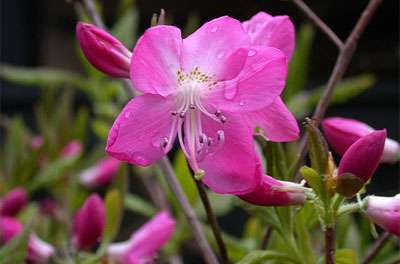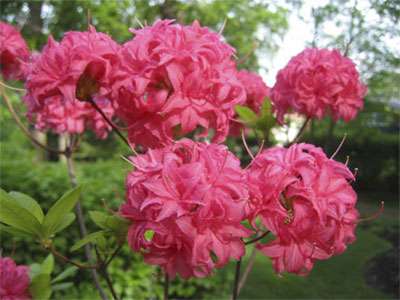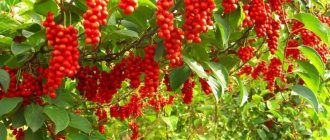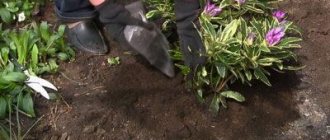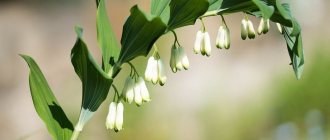Home »Landscaping» Lianas, Bushes and Trees
Lianas, Bushes and Trees
Vladimir Serchenko
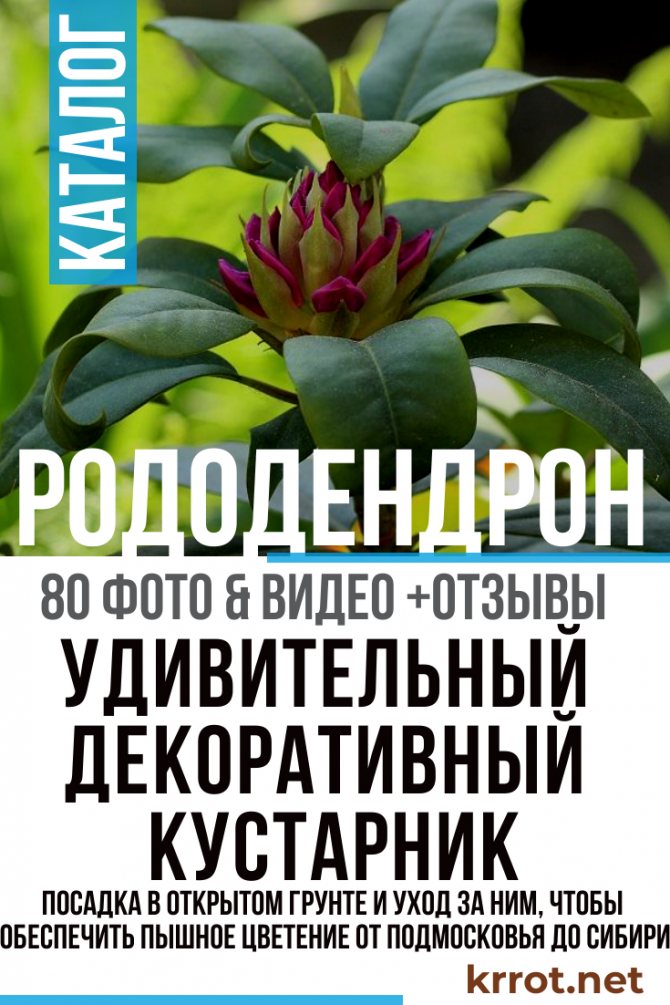
Rhododendron has come to the taste of many gardeners as an unassuming ornamental shrub with bright, beautiful flowers, some of which give off a fragrance. In order for an elegant bush to please the eye on the site, you need to know the rules for planting and caring for rhododendron.
- general description
- Landing
- What time is it preferable to plant rhododendron
- How to plant correctly
- Care
- Watering
- Weeding
- Spraying
- Top dressing
- Bush pruning
- Fight against harmful insects and diseases
- Reproduction
- Cuttings
- Layers
- Seeds
- Medicinal properties
- Features of growing in cold climates
- Types and varieties
- Pink rhododendron
- Rhododendron Katevbinsky "Grandiflorum"
- Rhododendron Helsinki
- Rhododendron Nova Zembla
- Rhododendron evergreen
- Rhododendron golden
- Rhododendron Adams
- Rhododendron Alfred
- Rhododendron Yakushimansky
- Roseum Elegance
Description of culture
Garden rhododendron is a shrub that is quite popular all over the world due to the beauty of its foliage and magnificent flowering.... Some species of this plant give off a bright floral scent. The foliage of the culture is annual or perennial, depending on the variety.
The shrub fruit is a small box with seeds. The bush has a fairly shallow root system, which makes it easy to transplant the plant to another place.
Rhododendron is an excellent early honey plant. Very popular with beekeepers.
Does rhododendron grow in Siberia
The rhododendron plant is a small shrub of the deciduous, evergreen or semi-deciduous type of the Heather family and has over 600 species in its genus. By default, it is generally accepted that beautiful rhododendrons are poorly suited for growing in regions with a harsh continental climate and prefer warmer and more humid places.
In fact, rhododendron in Siberia can be grown with great success. The plant requires little more care than any other ornamental shrub. And most importantly, there are many cold-resistant varieties of rhododendron that can easily tolerate even very harsh and long Siberian winters.
Planting conditions for rhododendron
In our area, only frost-resistant rhododendron can be planted, since the roots of this plant are located close to the surface of the earth, and in a harsh winter there is a high risk of crop death. Planting is best done in early spring or late autumn. In general, it can be transplanted into open ground at any time, except during the flowering period.
The planting procedure is quite simple:
- You need to dig a hole about 50 cm deep, fill it with a mixture of peat and clay. Tamp down the contents of the depression, and then dig a small hole in it the size of the root system of a bush. Before planting a plant, you need to hold its roots in water.
- The planted bush must be covered with earth and trampled down well. The root collar cannot be buried; it must be at the same level with the ground.
- After planting, water the bush abundantly.
It will grow best in the shade, in acidic soil rich in minerals.Perfectly neighbors with oak, pine and other deep-rooted and fruit trees. But alder, maple, chestnut and linden will destroy the rhododendron.
How to grow rhododendron in Siberia
Growing and caring for rhododendron in Siberia is not particularly difficult. When breeding this beautiful shrub, certain rules must be observed, however, in general, any gardener can safely plant one of the frost-resistant varieties on his site and enjoy bright flowering every year.
Landing dates
In warm and temperate climates, the rhododendron tolerates not only spring, but also autumn planting. However, Siberia has its own peculiarities - the first frosts start here very early, sometimes winter comes already at the end of September.
Therefore, it is recommended to plant a bush in Siberia only in the spring, in which case the shrub will have time to take root properly. When planting in the ground in autumn, even frost-resistant varieties can be seriously damaged during the first frosts, which will lead to inevitable death.
Landing site preparation
Rhododendron is not too picky about lighting and soil, but some features of the shrub must be taken into account. In particular:
- for planting a plant in Siberia, it is recommended to choose bright, but protected from direct sunlight places;
- the soil for rhododendron should be loose, with good aeration and an increased level of soil acidity;
- it is better not to plant rhododendron on a site in the immediate vicinity of which groundwater passes, the shrub does not tolerate swampy soil and may die;
- the shoots of the rhododendron are flexible, but rather thin, so it is better to plant the plant under the cover of some wall, fence or higher plants, otherwise a strong wind can break the branches of the bush.
If the site does not fully meet the requirements of the rhododendron, it can be additionally prepared - mix equal amounts of sand and peat, add dry needles and crushed pine bark and replace the ground at the site of the rhododendron planting with such artificial soil. At the bottom of the dug planting hole, it is necessary to lay a dense layer of drainage - a layer of at least 20 cm. It is recommended to fill the hole with complex mineral fertilizers, they will help the plant to take root faster and contribute to its healthy growth during the first years.
Landing rules
In open ground, rhododendron in Siberia is planted according to the standard scheme, which looks like this:
- in the selected area, a hole is dug about 0.5 m deep and up to 0.7 m wide;
- drainage is poured onto the bottom of the hole, and then 2/3 the hole is filled with prepared soil from peat, sand, needles and crushed bark;
- the rhododendron seedling is carefully lowered into the hole and sprinkled with its roots to the surface of the earth.
Immediately after planting, the rhododendron is watered abundantly, and then the soil around the shrub is mulched with a dense layer of needles or bark. In this case, the mulch should not fall into the place where the rhododendron bush branches out - this will harm the seedling and can provoke its death. The mulch layer should only cover the soil around the shrub, in which case it will prevent moisture evaporation and weed growth.
Attention! The root system of a rhododendron is superficial, therefore, it is impossible to deeply deepen the shrub during planting - this is fraught with root rot.
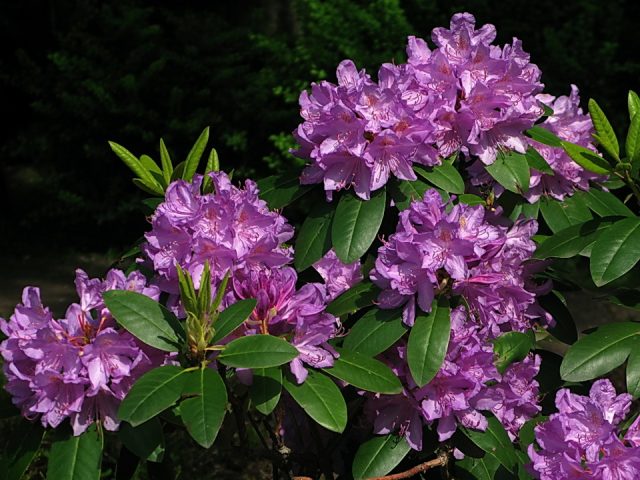

Watering and feeding
Despite the fact that the rhododendron is sensitive to waterlogging of the soil and can die from stagnant moisture, the plant also reacts negatively to drought. Rhododendron in Siberia needs to be watered regularly, especially in the spring, during the budding and flowering period, and in the summer, during the driest months.
The frequency of watering is determined individually - the fact that the plant needs moisture is evidenced by the slight drooping of the leaves and the disappearance of the glossy shine on their surface.However, in the midst of the summer heat in Siberia, it is worth prophylactically pouring 10 liters of water under the bush every week, in which case the rhododendron will definitely not dry out. It is also recommended to spray the crown of the plant once every couple of days.
As for feeding a plant in Siberia, the first 2-3 years it has enough fertilizers applied to the soil during planting. At the beginning of spring, you can add a little citric acid diluted with water to the soil - this will raise the acidity level.
An adult rhododendron is fed more often, several times per season. In March, it is recommended to apply fertilizers containing nitrogen to the soil, and in the summer and until the beginning of autumn, feed the shrub with superphosphate and potassium sulfate. Such procedures will make the flowering of the shrub in Siberia more lush and generally strengthen its vitality.
But lime and chloride fertilizers, like manure or bird droppings, should not be used for rhododendron, they alkalize the soil, which harms the shrub.
Pruning
Sanitary pruning is required annually for rhododendrons in Siberia and aims to remove any dried, broken, or diseased bush branches. If such prevention is not carried out, the plant's immunity will noticeably fall, and the risk of getting a fungal or viral disease will increase.
As for the decorative pruning of the crown, it is usually carried out no more than once every 3 years. Any haircut injures the plant a little, and since the natural forms of the bush are correct and aesthetic, it should not be stressed unnecessarily.
When decorative pruning rhododendron, the following rules are followed:
- the procedure is carried out in the spring until early April, until the buds begin to swell on the branches of the rhododendron;
- the shoots are cut about 1 cm above the growing point, which looks like a slight pinkish thickening on the branch;
- all cut sites are treated with garden varnish or other antiseptic solutions - in order to avoid infection.
After decorative pruning during the period of bud swelling and flowering, rhododendron in Siberia must be watched especially carefully. Particular attention should be paid to regular watering and high-quality feeding.
Protection against diseases and pests
Despite its hardiness and resistance to cold, rhododendron in Siberia remains susceptible to fungal diseases. Especially dangerous for shrubs are:
- rust is an ailment that manifests itself as bright orange spots on the leaves of a plant;
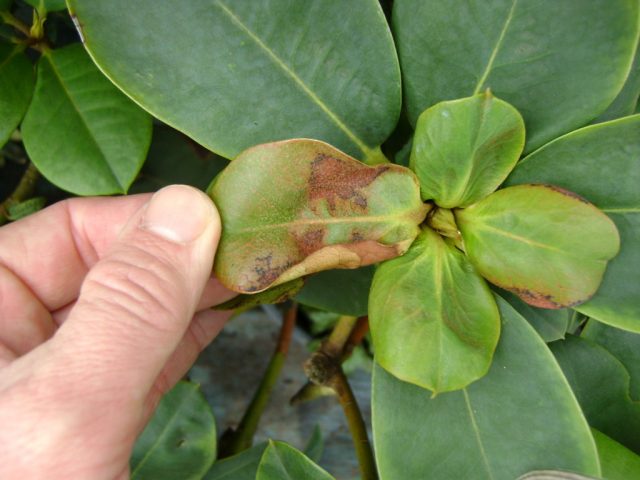

- leaf spot - the disease is expressed in the appearance of brown spots on the leaves of rhododendron;
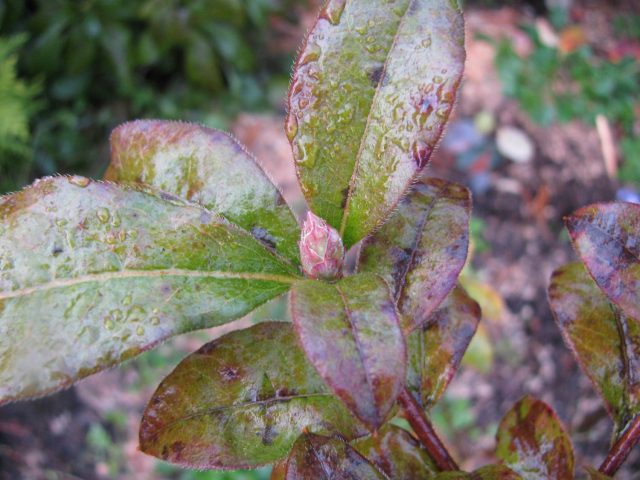

- chlorosis - with this disease, young shoots and leaves turn yellow and fade;
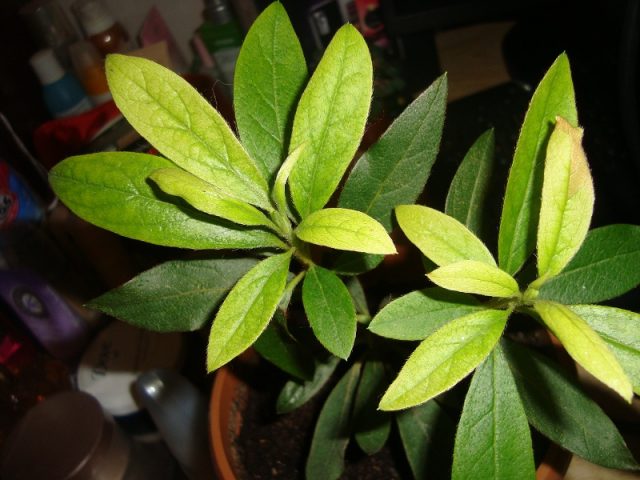

- bacterial cancer - the disease affects the root system of the plant and leads to its death.
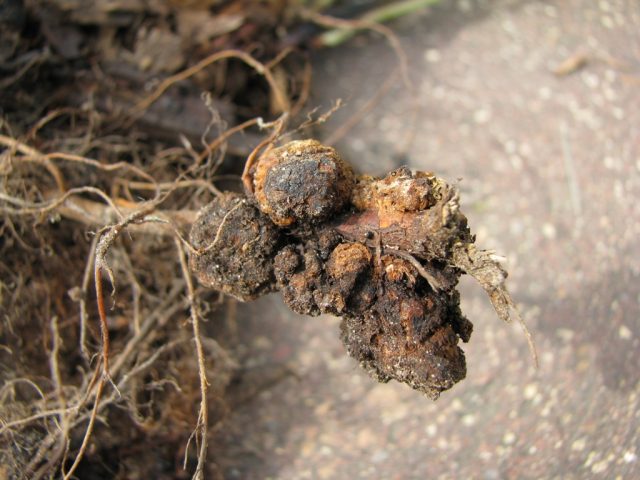

Most often, shrub diseases in Siberia arise due to the insufficient presence of oxygen in the soil, as well as due to waterlogging and poor sanitary condition of the soil. In order to treat rhododendron, high-quality sanitary pruning is carried out, during which all damaged parts of the plant are removed, and the shrub is treated with fungicides and copper sulfate. As a preventive measure, it is necessary to clear the soil of weeds and fallen leaves in time, annually carry out a sanitary shearing of the bushes and monitor the level of soil moisture.


In addition to fungal ailments, the plant is often affected by pests - weevils, scale insects, spider mites and other insects. To get rid of pests and prevent their further appearance, in spring and autumn shrubs in Siberia need to be treated with insecticides and Bordeaux liquid, paying attention not only to the crown, but also to the soil at the roots.
Bush care
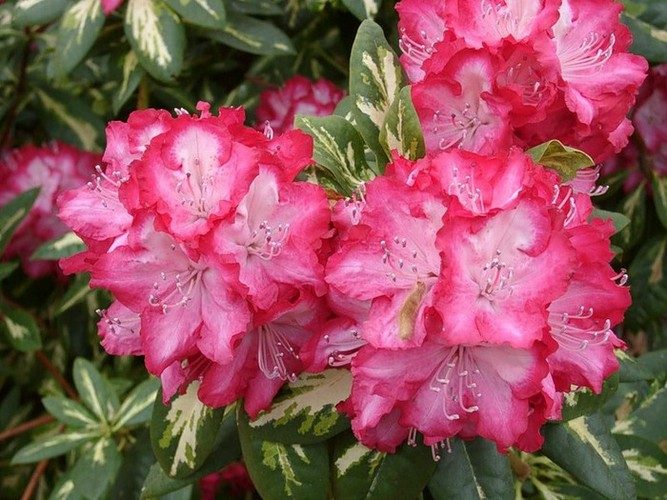

This plant is unpretentious and easy to care for. Care includes the usual procedures: weeding, watering, spraying, fertilizing and pest control.
It is impossible to loosen the soil next to the shrub, since the root system of the plant is located high, and there is a risk of damage to it.
Watering should be abundant and regular, especially during the flowering period of the shrub... You can determine when to water a flower by the state of its foliage: if it ceases to be glossy, then the plant needs water.
In the summer, at high air temperatures, you need to spray the plant. Watering should be adjusted so as not to overmoisten the roots.
Care rules
After the correct planting of healthy seedlings of rhododendron in Siberia, there is not so much left for their healthy growth.
Watering
Rhododendrons are quite moisture-loving plants and especially need abundant watering during flowering and budding. And of course, you need to pay great attention to watering and spraying the bushes during heat and drought.
Top dressing
The first few years after planting, rhododendrons do not need additional soil fertilization. As a top dressing with the onset of the growing season, you can acidify the soil with a weak solution of citric or oxalic acid.
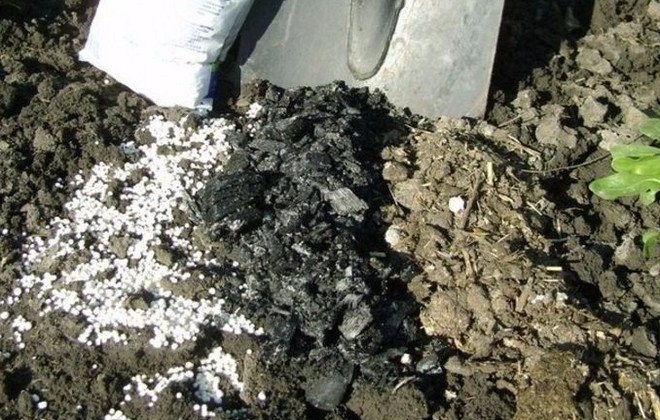

For adult plants, to increase the abundance of flowering, you can use ammonium nitrate, urea, superphosphate, potassium sulfate in a weak concentration. Top dressing is usually carried out several times per season: the first time in March and the last in the middle of summer.
Important! It is not recommended to use fertilizers containing chlorine and lime, as well as horse, pig or bird droppings as fertilizers for Rhododendron, as they disturb the acidity of the soil.
Soil care
The land under the bushes is usually not loosened or dug up. It is enough to water it abundantly, mulch it by at least 5 cm and feed it from time to time so that your plants will delight you with health and abundant flowering.
Pruning
Pruning, if necessary, is carried out the most minimal, preventive. For this, they choose the beginning of spring, that is, the month of March. In general, with the formation of the shape of the bush and pruning of "extra" branches in the rhododendron, it is better not to abuse it.


Plant pruning
Usually this shrub does not require pruning, as it forms a beautiful crown on its own.... Sometimes it is necessary to trim some branches or cut off frozen or dry shoots.
To do the correct pruning, you need to do it in early spring. Cutting points are to be treated with charcoal or garden varnish. After about thirty days, buds form on the shoots, the renewal process starts.
This shrub has such a feature: in one year, abundant flowering is noted, and in the next season, much less inflorescences are formed.... To get rid of this deficiency, it is necessary to prune half of the plant one by one after a year.
Reproduction of rhododendrons in Siberia
In Siberia, the plant is propagated in two main ways - by layering and cuttings. Growing a new bush from a cutting is carried out according to the following algorithm:
- in the middle of summer, several cuttings 10-15 cm long are cut from the lateral shoots of the rhododendron, they are cleaned of leaves in the lower part and placed in water for a day with a root growth stimulator;
- after that, the cuttings are placed in small containers filled with a suitable soil - a mixture of peat, sand and coniferous earth;
- the cuttings are watered, the containers are covered with foil and placed in a warm place for 3-4 weeks - this is how much time the cuttings will need to form roots;
- periodically, the film is removed - the cuttings should receive enough oxygen, besides, the earth needs to be moistened again from time to time.
By the arrival of September, the cuttings will be ready for transplanting into larger containers. For the winter, they must be removed to the basement or cellar, and planted in open ground with the onset of next spring.


Reproduction of rhododendron by layering is suitable for those who do not want to engage in numerous transplantations of cuttings. All that needs to be done in this case:
- find a healthy young bush shoot located low to the ground;
- make a small incision on it;
- tuck the shoot into a small groove dug in the soil, leaving the top of the branch on the surface.
To prevent the shoot from straightening, it is fixed with a staple or wire and sprinkled with earth. With regular watering, by the fall, the cuttings will give the first roots. He must endure the winter, being still associated with the mother plant. And with the onset of spring, the strengthened cuttings can be separated from the main bush and transferred to a new permanent place.
Shrub fertilization
This plant must be fertilized, even if recently planted. The first feeding is carried out in the spring. Before fertilizing, the plant must be watered. From organic fertilizers, manure diluted with water is suitable. Since the shrub grows in acidic soil, nitrogen agents and potassium phosphate can be used from mineral fertilizers.
It is best to fertilize the plant in spring with nitrogen-containing fertilizers, and at the beginning of summer with sulfate fertilizers.
Landing dates
The best time for planting young seedlings in the ground is early April. The soil should warm up to +10 C, the threat of frost should be avoided. Sowing seeds for seedlings begins in early February.
In autumn, it is better not to replant young rhododendrons, the plant will not have time to get stronger before the impending winter period.
Open root system
Rhododendron seedlings are often sold with an open root system. On the one hand, the gardener can discern the degree of development of the root system, and on the other hand, unscrupulous sellers often do not create favorable conditions for young bushes. They take root worse and get sick longer.
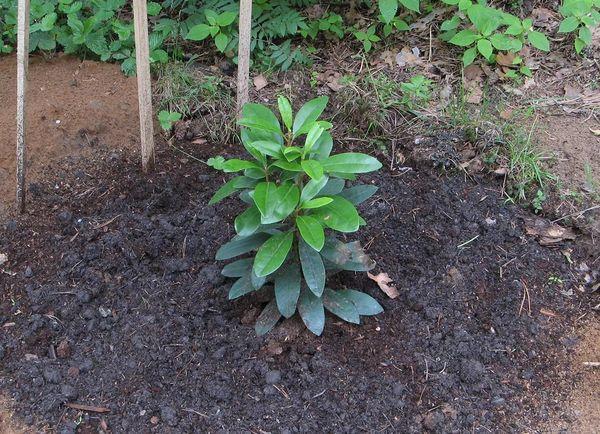

Closed
Potted seedlings are more viable. Planting is carried out together with an earthen clod, the root system is less injured, the plant takes root faster.
Diseases and pests
Most often, the following pests threaten rhododendron:
- mealy worm;
- spider mite;
- bedbugs;
- weevils;
- slugs and snails.
To combat these pests, you need to treat the plant with special solutions of insecticides and diazinones. Many pests die from karbofos.
Fungal diseases occur due to waterlogging and poor ventilation of the roots. Most of these diseases can be eliminated with a solution of copper sulfate.
Affected shoots and leaves should be removed and trimmed.
Medicinal properties
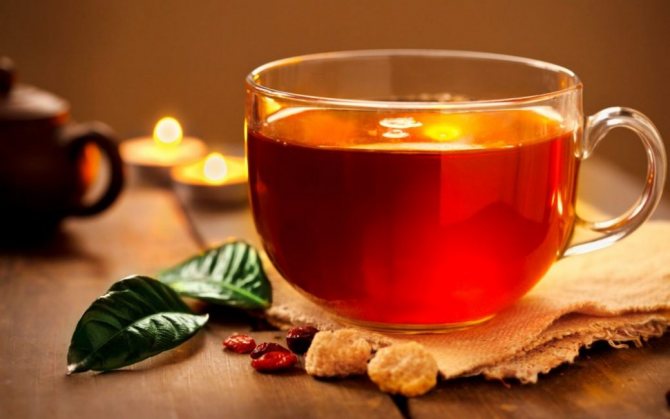

Flower tea helps with colds
Rhododendron contains ascorbic acid in large quantities, tannins, essential oils, phytoncides, rutin, tannins, arbutin, andromedotoxin, ericolin, and many other elements that make it possible to put it in a number of medicinal plants.
Caucasian, golden, Daurian, Indian rhododendron have clearly expressed medicinal properties.
Preparations made from the leaves and flowers of the plant give the effect:
1 bactericidal
2 pain reliever
3soothing
4 antipyretic
5 sweat
- Bactericidal properties used in the fight against staphylococci, streptococci, pathogenic microorganisms.
- Decoction of flowers helps in the treatment of diseases of the gastrointestinal tract. It is part of a diuretic drug for urolithiasis.
- Rubbing in sore spots, tinctures of leaves and flowers helps with polyarthritis, osteochondrosis, neuralgia, sciatica. The ability to remove fluid from the body is used in many diseases, as it helps to cope with edema, which contributes to better health. Used to treat diseases of the heart and blood vessels, hypertension.
- Leaf preparations relieve bronchial asthma, epilepsy, soften dry cough, have a beneficial effect on the lungs, relieve fever. The calming effect improves falling asleep, relieves irritability, nervousness.
- Infusion of leaves used as douching for uterine erosion.
- Flower tea relieves pain in the head, throat. Effective for colds.
- Alcohol tincture on flowers and leaves taken in case of poisoning with mercury vapors, inflammation of the mucous membrane.
Since rhododendron contains a small amount of toxic elements, preparations from it are contraindicated:
- Nursing mothers
- Women in position
- Patients with acute renal failure
The content of a large amount of essential oils makes rhododendron in demand in the perfume industry. Extracts from the plant are used to make perfume.
Features of spring care
In the spring, it is necessary to remove the shelter from the plants after the temperature regime is established at positive levels. It is recommended to remove the shelter from the rhododendrons gradually, which will protect the shoots from the negative effects of direct sunlight. The old mulch circle should be removed from the trunk circles. The first watering should be water-charging. For this purpose, water heated in the sun and settled water is used.
If there is a large accumulation of melt water, it is necessary to take measures to drain it from the rhododendron plantings. Spring care for rhododendron plantings includes activities such as watering, nutrient dressing, weed removal, loosening, pruning and pest protection spraying.
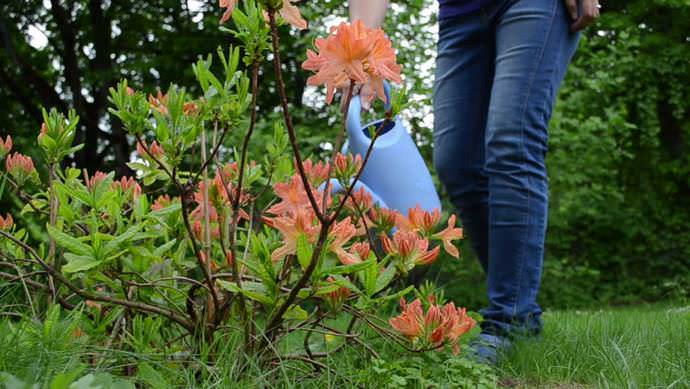

Cutting technology
Rhododendron needs minimal spring pruning, which is due to the plant's ability to independently form a fairly regular and attractive shape. In the spring, pruning of excessively tall bushes is carried out, as well as the removal of shoots frozen in winter or the rejuvenation of old plants. The event is held before the start of sap flow.
All sections must be processed with a garden varnish. About three weeks after pruning, buds awaken on the shoots, and part of the shoots are renewed. It is important to remember that very old or heavily frostbitten bushes in winter must be cut off at a height of 35 cm from the ground level. To reduce the indicators of the flowering frequency, it is recommended that all wilted inflorescences be timely broken out immediately after flowering in the spring.
Watering and fertilizing
Rhododendrons belong to the category of moisture-loving plants, so irrigation plays an important role. It is recommended to supplement irrigation measures with fertilization. Rhododendrons grow slowly enough but for full development they need periodic feeding. The main dressing is applied in the spring, after flowering, as well as at the stage of active growth of young shoots.
In early spring, you can apply a mixture of fertilizers based on ammonium sulfate, potassium sulfate and superphosphate under the plants in a ratio of 2: 1: 1. The use of such a fertilizer assumes the consumption of 80 g of the mixture per square meter. For adult and old plants, additional organic matter can be introduced in the form of rotted manure or compost at the rate of 1 bucket for each bush.
Plants respond very well to feeding with granular fertilizerswith “Kemira-universal”, which should be evenly distributed over the surface of the soil (1 tablespoon of granules for each square meter of area). For older and abundantly flowering plants, it is advisable to double the application rate of this fertilizer.


For further feeding, you can use a solution of potassium sulfate... It should be remembered that in the last decade of summer, feeding of rhododendrons is not needed, as they often cause late secondary growth and freezing of immature shoots in winter. For the same reason, experienced flower growers do not recommend using mullein for fertilizing.
Pest control
Typically, rhododendrons are affected by mealybugs, scale insects, spider mites, bedbugs, weevils, rhododendron flies, as well as snails and slugs. For the destruction of gastropods, manual collection and prophylactic treatment of plants with an 8% fungicidal agent is used. " In order to protect plantings from spider mites, rhododendron bugs and weevils, rhododendron and soil around the plants are sprayed with Diazinon. Treatment of flower beds in the spring with a standard solution of karbofos has good effectiveness.
Landing
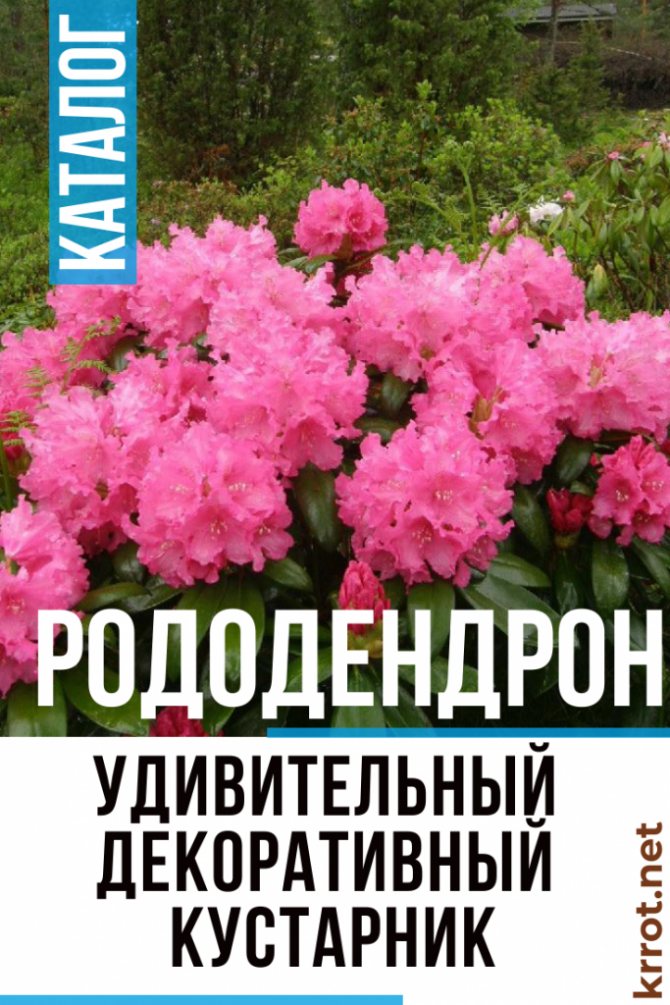

back to menu ↑
See also: Garden azaleas: description, varieties, planting and care in the open field, preparation for wintering (50 Photos & Videos) + Reviews
What time is it preferable to plant rhododendron
You can plant a garden rhododendron in the ground in the spring (from April to May) and autumn (from September to November). The optimal time for planting is indicated, although it can be carried out in a different period, the main thing is that the plant does not bloom. In northern latitudes, it is recommended to plant cold-resistant varieties.
For planting, choose a shaded place with loose, well-fertilized acidic soil. With high groundwaters, a raised bed is made to avoid decay. For the bush to grow well, you need to carefully select the surrounding trees. Should not be planted in close proximity to crops whose roots are at the same depth as rhododendra.
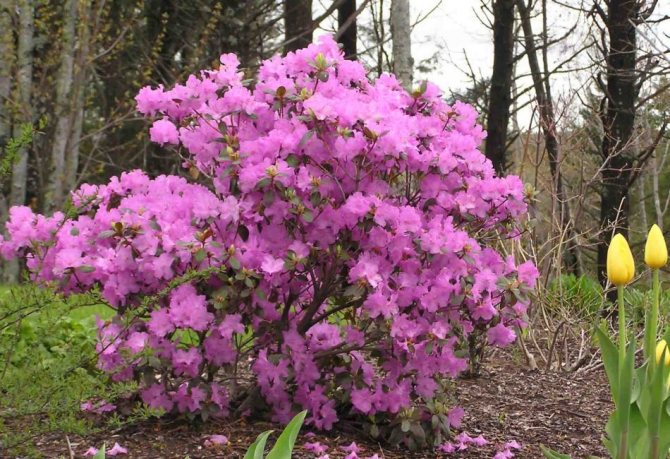

Spring and autumn are the best times to plant a plant.
You can plant a garden rhododendron in the ground in the spring (from April to May) and autumn (from September to November). The optimal time for planting is indicated, although it can be carried out in a different period, the main thing is that the plant does not bloom. In northern latitudes, it is recommended to plant cold-resistant varieties.
For planting, choose a shaded place with loose, well-fertilized acidic soil. With high groundwaters, a raised bed is made to avoid decay. For the bush to grow well, you need to carefully select the surrounding trees. Should not be planted in close proximity to crops whose roots are at the same depth as rhododendra.
Good neighbors can be:
- pear
- Apple tree
- Pine
- larch
- oak
These trees have roots quite deep. And poplar, elm, alder, maple, chestnut, linden will take away water and food from the shrub. If there is no way to avoid such a neighborhood, materials such as roofing material, geotextile, polyethylene film, which separate the border of plant growth, will come to the rescue.
back to menu ↑
Read also: Ageratum: description, planting in open ground and caring for it at home (30+ Photos & Videos) + Reviews
How to plant correctly
The main condition for planting is the acidity of the soil, in addition to the fact that it should be well fertilized with humus. You can check for acidity in a simple folk way. For this, currant or cherry leaves are poured with boiling water.
Throw a handful of soil into the cooled water. If the water changes color to blue, then the earth should be acidified. This is done by introducing rotted needles or sawdust of coniferous wood into the soil.
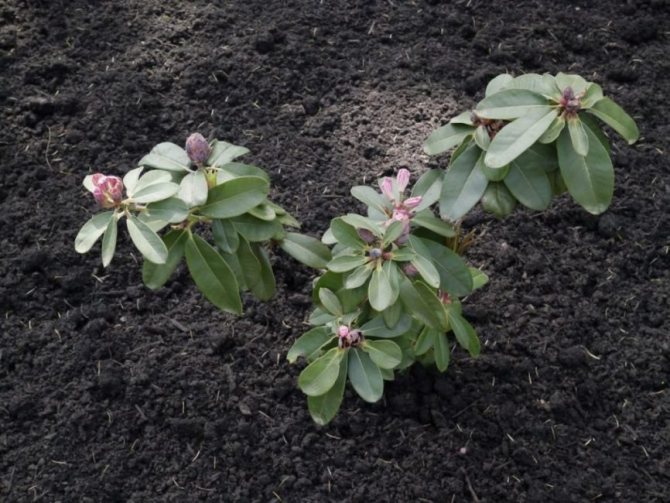

Fertilize the soil before planting
If the water changes color to green, this indicates the neutrality of the soil, and to red, then everything is in order, the earth has the required acid composition. A hole is dug half a meter deep and 60 cm wide. Pour in a mixture of peat, loam, taken in a ratio of 8: 3.5, tamp. Make the hole larger than the root system of the plant.
The seedlings are prepared for planting, they are kept in water until the rise of air bubbles stops. The seedling is lowered in such a way that the root collar is level with the ground.
The soil is compacted around.The bush should be watered abundantly, the soil around it should be covered with 5 cm of moss, peat or oak leaves. If there are a lot of flower buds on the bush, some of them are removed so that the main forces of the bush are spent on rooting.
If the plants are planted singly, they are tied to supporting pegs, which are removed after final rooting.
back to menu ↑
See also: How to create beautiful flower beds and flower beds in the country with your own hands? (220 fresh photos and video ideas) + Reviews
Care


Beautiful rhododendron - the result of proper care
The soil around the rhododendron must not be manually loosened to avoid damage to the roots located close to the surface.
Further care involves typical procedures for other cultures:
- watering
- weeding
- spraying
- top dressing
- pruning a bush
- fight against harmful insects and diseases
back to menu ↑
See also: Blueberries: a description of the 25 best varieties from early to late ripening. Secrets of agricultural technology and useful properties of berries + Reviews
Watering
Rhododendron is a moisture-loving plant, but excessive watering causes root rot. Watered with soft water: settled or rain.
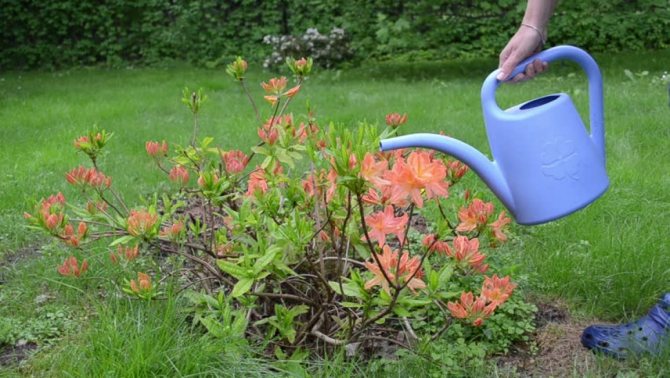

Excessive watering harms the plant
You can soften the water for irrigation by adding a few handfuls of peat a day before watering. The plant is sensitive to both drought and excess moisture. You need to be careful here. Watering is carried out when the leaves lose their elasticity and shine.
back to menu ↑
See also: Hydrangea (90+ Photos) - description, outdoor care, reproduction, transplant, disease (Video) + Reviews
Weeding
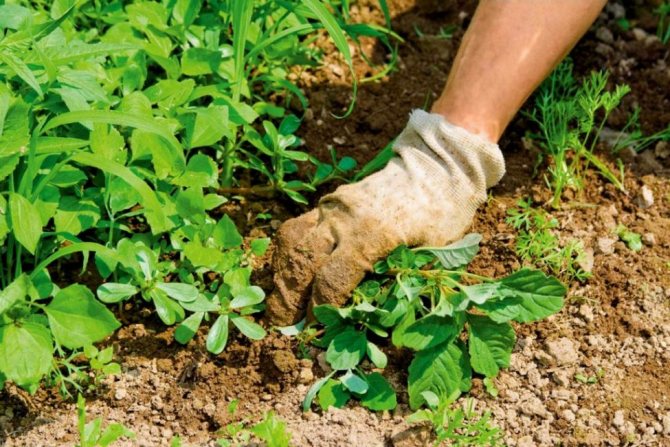

Weeds need to be pulled out by hand
It is recommended to pull the weeds out by hand, since using a hoe can damage the roots of high-lying plants.
back to menu ↑
See also: Pear: a description of the 24 best varieties with their photos and gardeners' reviews
Spraying
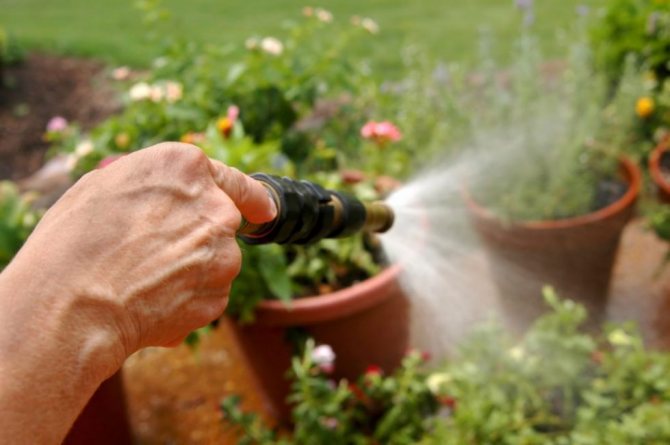

Frequent spraying of the bush is necessary
Since the rhododendron comes from countries with a humid climate, frequent spraying of the bush with soft water is shown.
back to menu ↑
See also: What to plant in the shade? TOP 35 Best Plants for a Beautiful Shady Garden
Top dressing
The plant needs constant feeding, even if the bush was planted this year. Fertilization begins in early spring and ends at the end of July, when flowering ends and young shoots begin to emerge.
Top dressing is made from semi-rotted cow dung. Manure, diluted with water in a ratio of 1: 15, is kept for several days. Before fertilizing, the bush is watered.
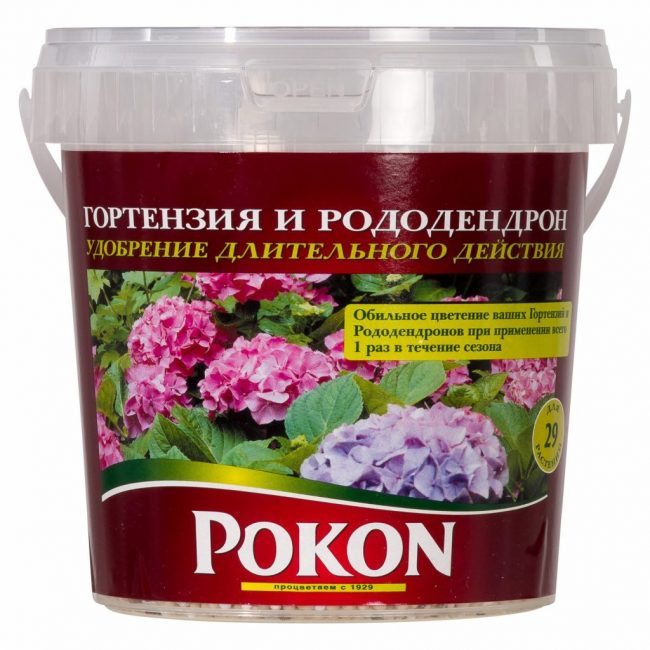

Long-lasting fertilizer
From mineral fertilizers are shown: phosphate, nitrate, potassium sulfate, ammonium sulfate, calcium and magnesium sulfate, superphosphate. Calcium, magnesium and potassium fertilizers are taken in a very small proportion: 1.2: 1000.
Nitrogen-containing fertilizers are applied in early spring - 50 grams of magnesium sulfate and the same amount of ammonium sulfate per 1 m2. In early June, after flowering, use 20 grams. potassium sulfate and superphosphate, 40 grams of ammonium sulfate per 1 m 2. Later, in July, add 20 grams. potassium sulfate and superphosphate.
back to menu ↑
See also: Barberry: description, types and varieties, planting in open ground, care, features for different climatic conditions including Siberia (65 Photos & Videos) + Reviews
Bush pruning
Rhododendron almost does not need crown formation, as it has the correct shape. Periodically, pruning should be carried out to remove dried branches, strictly rejuvenate the bush. Sometimes it becomes necessary to regulate certain bush sizes.
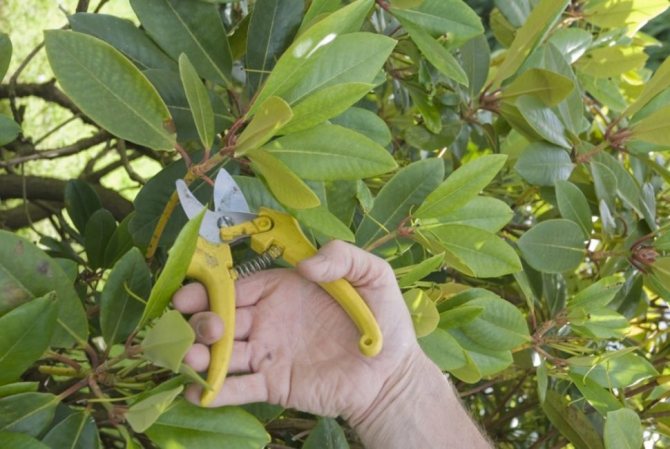

Rhododendron pruning is done in spring
Pruning is carried out in early spring. Cutting points of branches up to 4 mm thick must be treated with garden varnish. Pruning should be light, leaving at least three-quarters of the bush.
Rhododendrons bloom magnificently after a year. To have a beautifully flowering bush, it is recommended to remove wilted inflorescences immediately after flowering every year.This will provide an influx of energy for the plant to form new buds next year.
back to menu ↑
See also: Bobovnik - "golden rain" in your garden: planting in the open field, care, possible diseases, use in landscape design (55 Photos & Videos) + Reviews
Fight against harmful insects and diseases
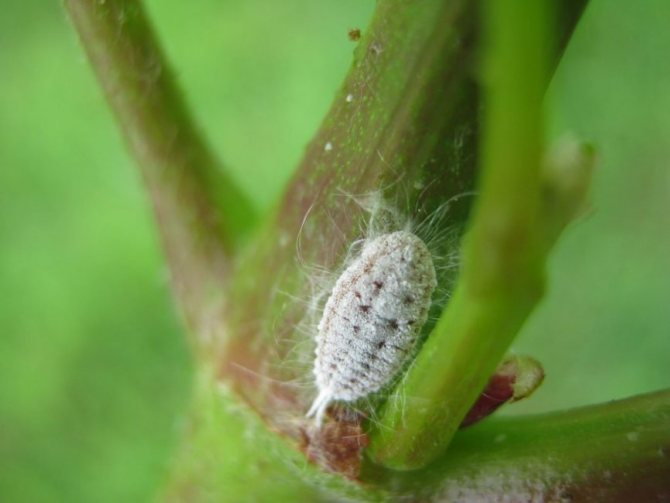

Mealybug
Due to poor air access to the roots, rhododendrons are susceptible to infection with fungal diseases.
The most common are:
- rust
- chlorosis
- leaf spot
- cancer
Yellowing of the leaves indicates chlorosis. To get rid of it, iron chelate is added to the water for irrigation. You can apply a solution of citric acid with iron vitriol. Copper sulfate preparations are used to combat spotting and rust.
Spraying the bush with Bordeaux liquid in early spring and late autumn helps a lot. It also prevents cancer from occurring. If the symptoms have already appeared, the diseased shoots are cut off.
The plant is often attacked by pests:
- weevils
- scale insects
- mealybugs
- spider mites
- bedbugs
- rhododendron flies
- slugs, snails
Molluscs are collected by hand. For preventive purposes, the plant is treated with an 8% solution of the fungicide TMTD. Weevils, bedbugs and ticks are destroyed with diazinon. Karbofos is used against flies, mealybugs, scale insects.
back to menu ↑
See also: Campsis: description, types, planting in the open field, reproduction and care of a beautiful liana (85+ Photos & Videos) + Reviews
Reproduction
Rhododendron reproduces at home in several ways.:
- Seeds. The seed is sown in containers with earth, sprinkled with sand and covered with glass. The container is placed in a bright place; daily ventilation is required. The first shoots appear within thirty days. Seedlings can be planted in the ground after the formation of two true leaves. It is better to leave the young plant in the greenhouse until the development of a full-fledged root system. A rhododendron grown in this way does not bloom until eight years later.
- Layers. The most popular and uncomplicated breeding method for rhododendron. To do this, you need to dig the longest shoot next to the bush and press it down with a dense layer of earth. The tip of the shoot must remain above the ground. Until next spring, the cuttings are watered and only at the beginning of summer they are separated from the mother bush, planting in a permanent place.
- Cuttings. For reproduction in this way, you need to cut off a stalk 8 cm long. The lower cut of the stalk is immersed in a root growth stimulator for 12 hours. Then you should bury the cuttings in peat with sand and cover with plastic. The cuttings take root for a long time, within three months.
Rhododendron evergreen
This type of rhododendron differs in that it does not shed its leaves for the winter, but they only fold back, returning to their original form in the spring.
It includes several subclasses:
- golden
- Adams
- Alfred
- Yakushimansky
- Roseum Elegance
- Katevbinsky
back to menu ↑
See also: Clematis: description, classification of varieties, cultivation, planting and care in the open field (50 Photos & Videos) + Reviews
Rhododendron golden


Rhododendron golden A low wild-growing shrub in the regions of the Far East, Siberia, Buryatia.
Reaches a height of 60 cm, sometimes up to one meter. Elongated dark green elliptical leaves are 8 cm long and 2.3 cm wide.
Golden-yellow flowers reach 5 cm in diameter. Inflorescences have up to ten flowers. The pubescent filaments end in anthers up to 2 mm in size.
It does not take root very well in artificial conditions. Although there is information about successful cultivation from seeds. It is successfully grown in the Baltic States and Finland. Outside the zone of natural growth, due to the divergence of natural conditions, the bush is difficult to take root. It gets sick and dies.
back to menu ↑
See also: Magonia: holly, creeping, apollo, atropurpurea - edibility and usefulness, decorativeness, care, planting in open ground (115+ Photos & Videos) + Reviews
Rhododendron Adams
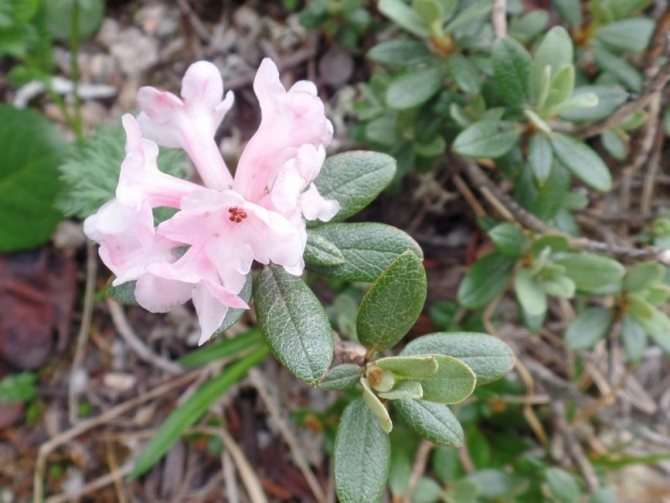

Rhododendron Adams It is also known as Buryat tea, fragrant wild rosemary, Belogorsk tea. The natural habitat is the rocky slopes of the high mountains of Buryatia.
This is a short shrub that grows up to half a meter in height. The elongated leaves are two centimeters long and one centimeter wide. Green leaves change color to reddish-brown with age.
Hairy shoots are covered with scales. Light pink flowers 1.5 cm in diameter are collected in inflorescences that contain up to 15 flowers. I bloom from June to August.
The shrub has medicinal properties equal to those of ginseng and lemongrass. Energy-reducing and stimulating drugs are prepared from it. For the preparation of medicinal fees, inflorescences and leaves are used.
The drugs are used to restore immunity, from colds, as a sedative. It is used in gynecological practice in the fight against infertility.
Tea brewed from the petals and flowers of the plant improves heart rate, improves cerebral circulation, thereby improving mental performance.
back to menu ↑
See also: Chubushnik: description of 20 varieties, planting and caring for shrubs in the garden, possible diseases (110+ Photos & Videos) + Reviews
Rhododendron Alfred
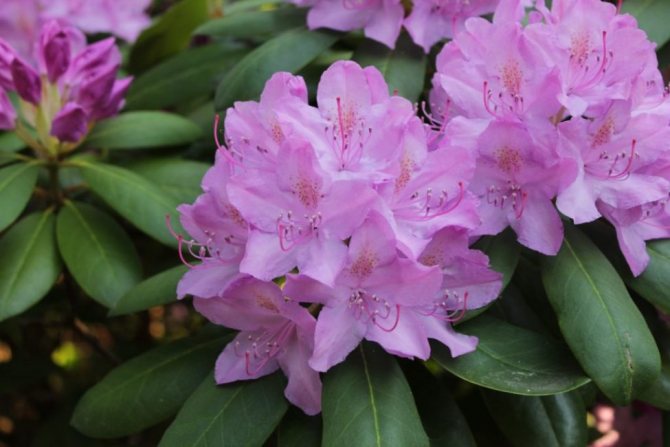

Rhododendron Alfred Hybrid bush up to 1.2 m high with a one and a half meter crown.
Elongated, shiny dark green leaves are 15 cm long and 5 cm wide. Large purple-red flowers with an olive spot in the middle reach 6 cm in diameter, collected in inflorescences of 20 flowers.
Flowering begins in June and lasts about 20 days. Used for both single and group planting in shaded areas.
back to menu ↑
See also: Forsythia: description, planting in the open field, leaving the Moscow region to Siberia - mini-encyclopedia (80+ Photos & Videos) + Reviews
Rhododendron Yakushimansky


Rhododendron Yakushimansky A beautiful evergreen shrub with pale pink flowers at the beginning of flowering. As it blooms, the color changes to dazzling white.
Flowers with a diameter of 7 cm are collected in inflorescences of 7 pieces. Flowering begins in May and ends in June.
The bush has a rather wide crown with a diameter of 1.5 m and a height of up to one meter. Another feature that is pleasant for gardeners is that the plant is resistant to diseases and pests.
back to menu ↑
See also: Magnolia: a description of 15 species, recommendations for planting, reproduction and care (90 Photos & Videos) + Reviews
Roseum Elegance
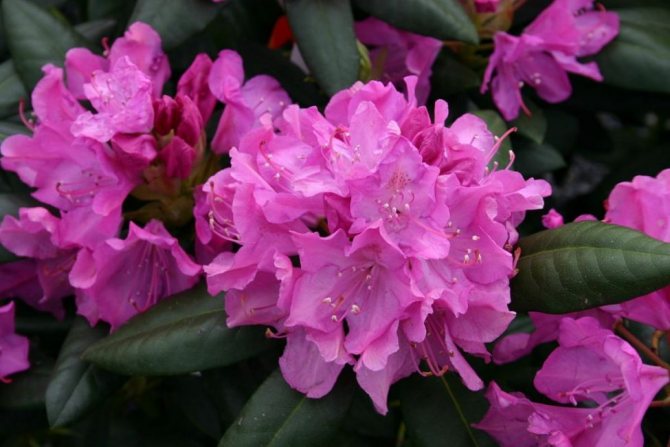

Roseum Elegance The shrub reaches a height of 3 meters. Has an almost regular spherical shape.
Funnel-shaped flowers with wavy petals at the edges are collected in inflorescences up to 15 pieces. The flowering plant has a beautiful appearance, which makes it the preferred choice for landscape design.
Only the leaves that have appeared have a reddish color, which changes to dark green during the growth of the plant. We love gardeners for decorativeness at any time of the year and frost resistance.
See also: Growing garden blackberries - a description from buying a seedling and planting it in open ground to leaving and harvesting from the Moscow region to Siberia + Reviews
Rhododendron varieties
There are a huge number of species and varieties of this beautiful shrub. Below are the most popular ones..
- Rhododendron Daursky. This shrub can grow up to four meters in height. It has brown shoots with small leaves, some of which fall off in the winter. It blooms for about a month with large purple flowers.
- Rhododendron Adams. It grows up to 50 cm in height, producing large leaves and pink flowers. This type of rhododendron is listed in the Red Book.
- Rhododendron Japanese. The most beautiful rhododendron up to two meters in height. The foliage turns orange-red in autumn.It tolerates frost well and reproduces well.
- Rhododendron Caucasian in several varieties. The yellow flowers of this shrub exude a very pleasant aroma.
- Alfred. Hybrid shrub with oblong leaves and red flowers.
- Blue Peter. Two-meter plant with lilac flowers.
- Jacksoni. The flowers of this bush are collected in pink inflorescences.
In our latitudes, this beautiful shrub normally tolerates small frosts, but it is still better to cover it for the winter. It does not require special care and reproduces successfully. Such a plant will become a real decoration of any garden or suburban area.
Types and varieties
The plant has multiple varieties. Let's consider some of them, common in the regions of Russia.
back to menu ↑
See also: Plastic bottles, what can be made of them? Useful DIY crafts: for home and summer cottages (60+ Photo Ideas & Videos) + Reviews
Pink rhododendron


Pink rhododendron A deciduous shrub native to Canada. Frost-resistant, withstands cold up to -30 degrees. The leaves are ellipsoidal, up to three centimeters in size, covered with villi. The height of the bush ranges from one to three meters.
The inflorescence contains up to 9 flowers. Flowering begins with the appearance of the first leaves in April and lasts two weeks. The plant prefers stony soil, preferably planted in groups. Avoid locations with groundwater.
Propagated by layering, bending the shoots to the ground, and by seeds. If the plant is properly cared for, it can delight with lush flowering twice a year.
back to menu ↑
See also: Bubbles: species, description of 18 popular varieties, planting and care (80+ Photos & Videos) + Reviews
Rhododendron Katevbinsky "Grandiflorum"
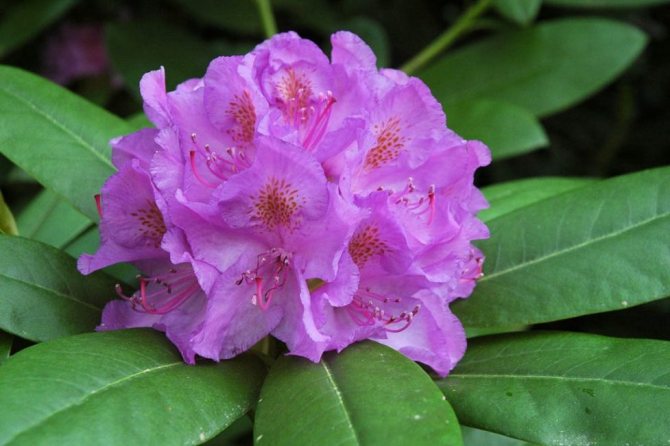

Rhododendron Katevbinsky "Grandiflorum" This type of shrub has a magnificent appearance during flowering. This plant reaches a height of 6 meters. The overgrown dense semicircular crown has a diameter of up to two meters. Used in group plantings. Complements landscape design, can be used as a hedge. Loves lighted places, is afraid of drafts.
The bark has a brown tint. Elongated dark green leaves up to 15 cm long and up to 5 cm wide. Above - dark and shiny, below matte and light with visible dark veins.
Flowers in the form of bells are lilac, white, purple, violet-red. In the inflorescence, there are up to 20 flowers with a diameter of about 6 cm. The flowering plant is a grandiose sight, capable of decorating the most sophisticated landscape from May to June. Fruits are formed in October and look like bolls.
The plant is used to decorate fences, paths, arbors. With the help of plantings, you can create colorful compositions, combining with other cultures. Looks beautiful next to thuja and cypress.
Since the shrub grows well upward, pruning is recommended in the form of pinching individual shoots. The plant is hygrophilous, so in hot weather it is best to provide deep watering.
back to menu ↑
See also: How to make and decorate beautiful garden beds with your own hands: simple, tall, smart. For flowers and vegetables. Original Ideas (80+ Photos & Videos)
Rhododendron Helsinki
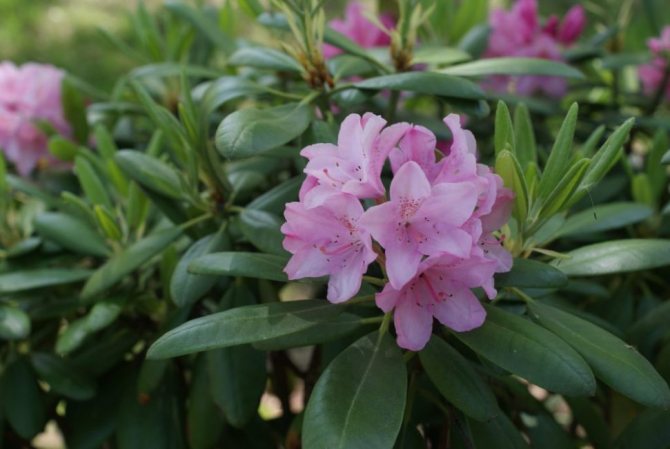

Rhododendron Helsinki A winter-hardy evergreen variety bred in Finland. This is the most resistant bush to weather extremes and the effects of cold. The height of the bush reaches 1.7 m with a crown diameter of 1.5 m. The dark green leaves reach 15 cm in length.
Delicate pink flowers with dark red specks in the upper part of the petal are funnel-shaped with a diameter of 7.5 cm. A distinctive feature is the slightly wavy edges of the petals. Flowers are collected in inflorescences with up to 18 flowers. Young plants bloom in early summer (June).
The shade-loving plant can bloom even in the shade of trees and buildings. The bush tolerates frosts down to -40 degrees.
For better flowering, remove faded inflorescences and seed boxes. For a successful wintering, the plant is watered. Good watering must be ensured in hot weather - 12 liters for each bush twice a week.
Weeding is done by hand, leaving the weeds next to the bush for mulching. Propagated by cuttings and seeds. Planting with seeds does not make it possible to get a flowering bush in a quick time, flowering begins only in the fifth or sixth year.
From this side, cuttings are effective. Flowers appear in a year. The plant reproduces well by layering, providing flowering in a year.
Planting is carried out in separate groups, I select plants of various colors. For the choice of the composition, they are combined with evergreen shrubs, differing in the height of the bush.
The beauty of rhododendron flowers is especially impressive against the background of the dark crown of firs, cypresses, pine trees. It goes well in composition with creeping crops in rock gardens.
back to menu ↑
See also: Hosta: description, types and varieties, planting in the open ground and care, possible diseases (120+ Photos & Videos) + Reviews
Rhododendron Nova Zembla
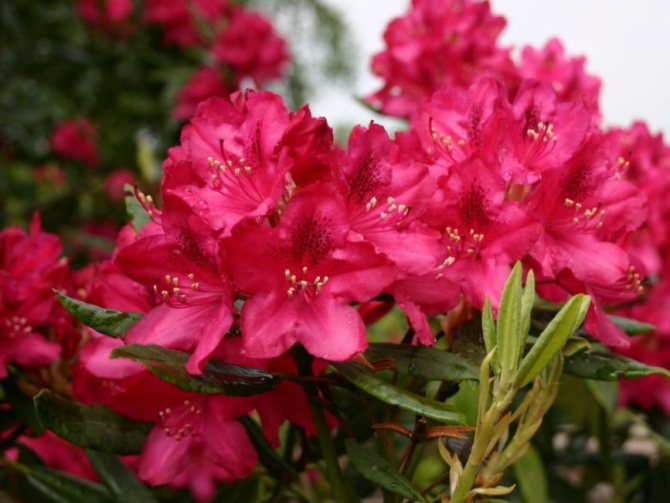

Rhododendron Nova Zembla This is a hybrid variety, named after the island of the same name on Novaya Zemlya, pleasing to the eye with bright red lush inflorescences. The size of the flowers reaches 10 cm. In the inflorescence, there are up to 12 bell-shaped flowers.
The ruby color of the petals with brown spots in the center and golden anthers is a magnificent sight. Elongated leathery leaves with a dark green surface and light on the back. The branched trunk is gray in color.
The evergreen shrub is cold-resistant. The bush grows rapidly, reaching a height of two meters. Has a spreading crown. Branched trunk of gray color.
A distinctive feature is that it can be grown without shelter for the winter, hibernates in a frost of -30 degrees. In the conditions of a particularly harsh winter in the Urals and Siberia, the bush is covered with a protective frame for the winter. Young, immature shrubs also require shelter with the onset of cold weather.
The bush blooms in May – June. Bright spots are the preferred landing site. It is better to grow on the northern slopes of the mountains, in the shaded corners of the site. The plant does not like strong winds. Feels good in planting next to pine trees.
The plant looks beautiful on large personal plots, in the garden, near reservoirs in the form of group plantings. Effectively combined with other varieties of evergreen rhododendron, which benefits from the use of contrasting colors. It turns out to be an enchanting sight.
The main methods of propagation of a shrub are cuttings and layering. Seed propagation for evergreens is not particularly used, since this method leads to the loss of varietal characteristics.
back to menu ↑
See also: Boxwood: description, types and varieties, planting in the open ground and caring for shrubs, use in landscape design (85+ Photos & Videos) + Reviews
Features of landing in the Moscow region, Siberia and the Urals
This plant is thermophilic, therefore, for the Moscow region, you need to choose varieties that can survive the winter frosts. Due to the superficial location of the root system, the likelihood of freezing of the shrub remains even under cover.
Rhododendron in Siberia... Planting and caring for such a shrub should include mandatory mulching and shelter for the winter. You need to choose deciduous varieties of rhododendron: Japanese, Kamchatka, yellow and others.
Rhododendrons in the Urals... Care and planting of a plant in this region begins with the selection of a cold-resistant variety, for example, The Hague, Mikkeli, Rosie Lights. It is imperative to cover the rhododendron for the winter to avoid hypothermia.
The unique beauty of rhododendron inspires gardeners; for many, caring for an exquisite heat-loving shrub becomes a real pleasure and develops into a hobby.Growing rhododendron cannot be called easy, you need to choose the right place where to plant it, monitor soil moisture and protect it from pests. But if you make an effort and provide the plant with proper care, then this rare beautiful plant will be a real gem of any garden.
Growing features
Now let's find out what are the features when growing rhododendrons in a garden in Siberia.
Climatic conditions
When choosing a variety for cultivation, you should always take into account the climate of your area - it should correspond as much as possible to the usual conditions of natural plant germination.
The sharply continental climate of central Siberia is well suited for growing the above frost-resistant varieties of rhododendron, although this plant is considered more thermophilic.


Soil type
Rhododendron bushes love to grow in loose soil with high acidity. To give the soil the desired composition, add peat to it, mixed with sand, fractional pine bark and needles.
In order to prevent the roots of shrubs from rotting in swampy soil, a prerequisite will be the presence of drainage at the bottom of the planting holes, with a layer of 20 centimeters.
Important! Planting in the fall is not advisable, as the plant will not have enough time to take root, adapt and calmly meet the winter frosts. There is a great risk that the bush will not take root and die.
The benefits and harms of rhododendron
Rhododendron is used to decorate areas, but it has useful qualities that have found application in conventional and traditional medicine. The presence of vitamin C, andromedotoxin, ericoline, arbutin and rhododendrin has led to its use:
- will help reduce fever, pain;
- will have a calming and bactericidal effect;
- relieve swelling;
- remove excess fluid from the body;
- will lower the pressure.
Contraindications: pregnancy, breastfeeding, kidney disease and tissue necrosis.
It is best to treat with the advice of your doctor. This will protect you from uninvited consequences or death, which is possible because many species are poisonous.
Landing in a permanent place
It is necessary to choose a site for growing rhododendron right away, the plant does not like frequent transplants. The main parameters to consider when choosing a location:
- The site should be well lit, preference is given to the east or west side.
- It is necessary to maintain the distance between neighbors, some varieties of rhododendron form sprawling bushes.
- The area should not be swampy, there are no drafts.
The landing hole is dug deep enough. Drainage from expanded clay and sand is installed at the bottom. After planting, the earth is tamped, the bush is watered abundantly. Rhododendrons prefer acidic soils.
Features of "trees with roses"
There is no need to rush to buy outlandish bushes or trees from an advertising picture, since it will be a pity for the money, time and effort spent if the plant on the site starts to wither after planting, and eventually dies altogether. To avoid such a fate, you must first find out what kind and variety of this heat-loving plant can survive the cold autumn and frosty winter. Some varieties of rhododendrons, even under cover, do not withstand frosts.
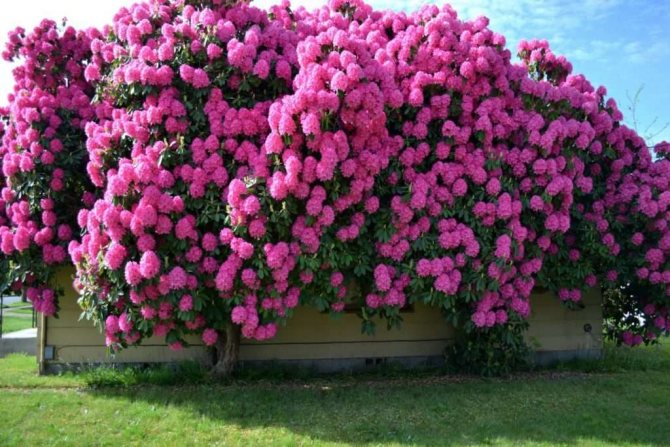

In areas with a cold climate, you can grow and preserve deciduous rhododendrons: Schlippenbach, Kamchatka, Vaseya, Canadian, Japanese, Yellow, Pukhansky. The semi-evergreen species, Ledebura, will remain, as well as the evergreen Katevbinsky species. His hybrids are often planted: Abraham, Alfred, Lincoln, Nova Zembla, Cunningham White. Among the hybrids of Smirnov's rhododendron, the following varieties are in demand: Laika, Dorothy Swift and Gabriel. Of the winter-hardy Finnish varieties, the Hague, Mikkeli and Elvira are most often planted. For mid-zone winters, such hybrids as Spicy Lights, Pink Lights, Northern Light - Rosie Lights and others, which we will discuss below, are suitable.
Deciduous and semi-evergreen trees up to 1.5-2 m in height and shrubs 50-100 cm in height, which have a branched, spherical or ellipsoidal crown shape, tolerate the cold climate better. The branches are decorated with dark green leaves of a round, oval, spear-shaped shape. In autumn, they turn crimson and stand out from other plants. Plants begin to bloom in the last decade of April - in early June and delight with all kinds of flower shapes and a wonderful aroma for 2-3 weeks.
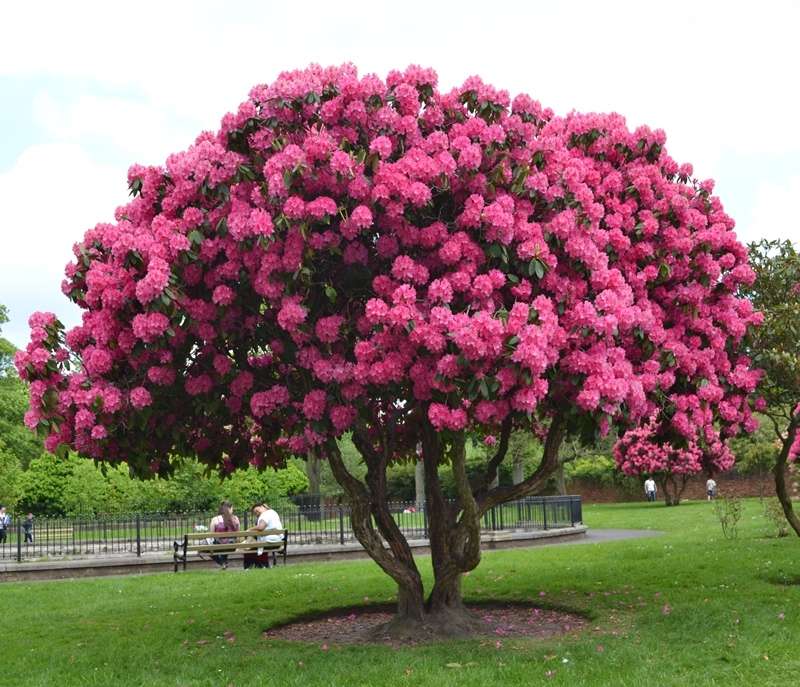

Where to plant a rhododendron to make it feel good? In the garden, they always look more spectacular if planted in groups. Crops should have different flowering times to enjoy this vibrant period of rose trees. The most comfortable place for a plant is the area near ponds or fountains, since these crops love moisture. If there are none, then it will be necessary to increase the humidity artificially: spraying using spray guns and hoses with special nozzles for "rain".
What kind of soil does rhododendron like? Pink trees prefer acidic soils, so next to them you can plant the same lovers: lingonberries, cranberries and blueberries, ferns to contrast the texture of leaves, flowering bulbs and other perennials.
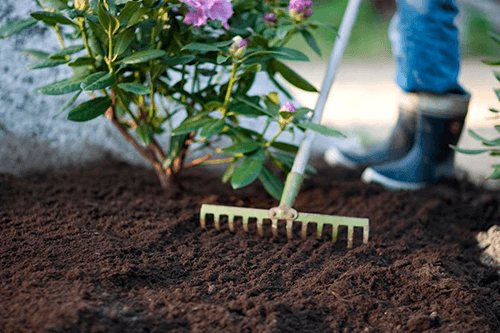

High decorative qualities are not all the advantages of “trees with roses”. Their medicinal properties are widely used by traditional and folk medicine. In Daursky, Golden, Caucasian and Adams rhododendron, there is a large percentage of andromedotoxin, ericolin, arbutin and rhododendrin. The leaves are rich in ascorbic acid, especially in summer. Means with the addition of medicinal substances are used for the following effects on the body:
- bactericidal and analgesic;
- antipyretic and diaphoretic;
- soothing and reducing pressure: arterial and venous;
- reducing high heart rate;
- increasing the activity of the heart.
The drugs reduce swelling by removing excess fluid from the body, relieve shortness of breath. But contraindications must also be taken into account, since the funds can harm pregnant women or women with newborns during lactation. Preparations based on rhododendrons are not recommended for serious kidney disease. Self-medication is generally contraindicated. Such medicines can only be prescribed by the attending physician.
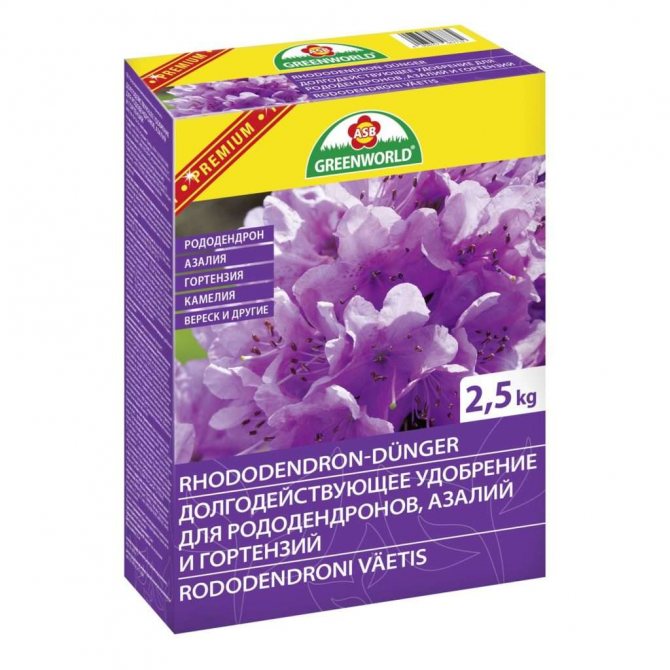

The peculiarity of the plant is that annual, biennial and perennial shrubs have decorative leaves of different sizes and shapes: sessile or petiolate, alternate, serrate or entire, ovate or obovate. The main advantage of the "rosewood" is white, pink, red, purple, lilac colors of brushes with flowers that look like a beautiful bouquet. In shape, flowers are bell-shaped, funnel-shaped, wheel-shaped or tubular. Inflorescences of some species emit a pleasant and delicate aroma that has a positive effect on the human nervous system.
In early spring, the melliferous qualities of flowers attract bees to the garden, trees and bushes are often planted in apiaries. After flowering, the plant ripens the fruit in the form of a five-leaf box with many seeds up to 2 mm. The fibrous and compact roots of the culture are located superficially, so planting and replanting a plant is not difficult, as well as caring for it.
How to transplant a rhododendron to a new location
Since it is rather difficult to take good care of a rhododendron in mid-latitudes, the plant may not look so bright next year. An unfortunate location or freezing winters can also greatly affect the lushness and regularity of a rosewood.
Transplanting a young plant will help correct the situation. This is done in early spring or early autumn. It is important to choose a period when the weather is cool enough and the air humidity is high.
Advice! When transplanting, you can mark the branches of the plant to the cardinal points.This will help to properly position the bush in a new place so that its "move" is not so stressful.
How to choose a seedling
The success of growing rhododendrons largely depends on the choice of a healthy seedling. Before buying planting material, it is necessary to inspect for signs of fungal and bacterial infections, to assess the degree of development of the root system.
Appearance
What should a healthy seedling look like? The main signs are:
- The age of the bush is 2-4 years, it is during this period that the seedling takes root best.
- The root system is well developed, many branches extend from the base of the root, there are no decaying parts.
- Leaves of uniform saturated color, without spots and scuffs.
- The trunk is strong, without plaque or damage.
Pay attention to the manufacturer of the seed. For cultivation in Siberia, it is recommended to choose varieties of Finnish selection.
Bad signs
If signs of unfavorable conditions of keeping and symptoms of diseases are noticeable on a young seedling, the purchase should be postponed. Adverse signs are: the presence of pimples on the leaves, "wet" spots and nodules on the roots.
Brief Recommendations
In countries with harsh climates, deciduous "pink trees" of semi-evergreen winter-hardy species are planted.
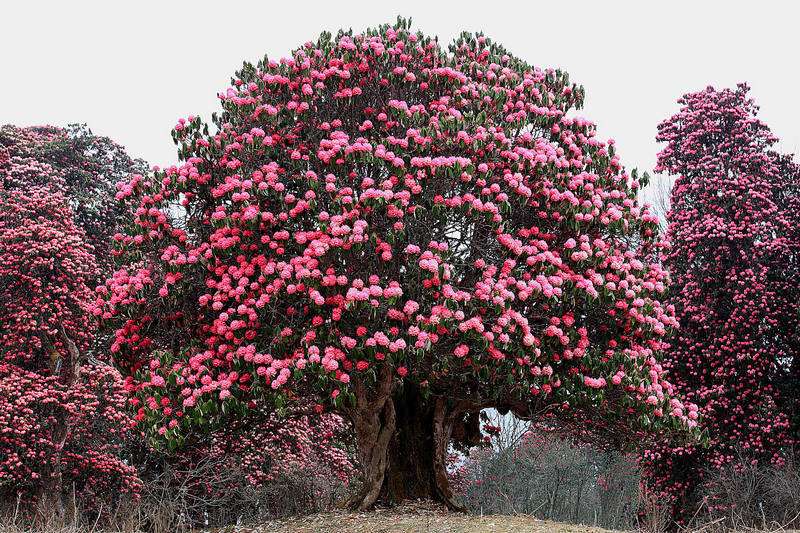

These include the deciduous Schlippenbach, as well as the Japanese and Katevbin rhododendrons, the cultivation and care of which will be easier if the following brief recommendations are followed:
- Plant plants in April - until May 10 or September-November.
- Place seedlings in partial shade or shade.
- It is necessary to select a well-drained, loose, humus-rich, acidic soil for rhododendrons.
- Water trees (bushes), moistening the soil to a depth of 20-30 cm and slightly acidifying the water. If the leaves of the plant lose their turgor, it means that the time for watering has already come.
- Top dressing for seedlings is: liquid organic matter (cow dung or horn flour with water) or mineral fertilizers, which are applied to the soil in early spring, until the end of July, into a pre-moistened soil.
- Cut trees or shrubs minimally before sap flows in early spring.
- Propagate the crop using grafts, cuttings, cuttings, seeds and dividing the bush.
- Fight pests: aphids, mealybugs and bedbugs, weevils, spider mites and scale insects, rhododendra flies, snails and slugs.
- Treat possible diseases: chlorosis, rust, powdery mildew, leaf spot and cancer.
What year does rhododendron bloom after planting
Vegetative varieties of rhododendron can bloom fully the next year after planting. The first flowering (in the year of planting the seedling) must be cut off so that the plant gains strength for active growth and development.
Agapanthus: planting and care in the open field
note! There are times when this bush blooms magnificently and for a long time for one year, sparsely for the second year, and so alternately. To avoid this situation, you need to immediately cut off the faded inflorescences. This will help the woody rose to direct the juices to the blossoming buds rather than the dying ones.
Rhododendron - a beautiful fantasy of nature
The composition of the substrate may include: high-moor peat, leafy soil from under broad-leaved trees, heather land, rotted pine and spruce needles, a mixture of peat compost with sand, a mixture of high peat and coniferous litter. Experts advise the following substrate options for rhododendrons: - leafy soil, high peat, coniferous litter in proportion (3: 2: 1); - heather, leafy soil, coarse sand (3: 1: 1); - sod land, sphagnum peat, coarse sand (1: 4: 1). Various other combinations of the constituents of the acidic fertile substrate necessary for the rhododendron are also used.
You can pour some large, aged sawdust into the substrate; it would be good to mix pieces of broken red brick into it to retain moisture.
It is also recommended to add 30-50 g of special fertilizer for rhododendrons or any complex fertilizer to the planting pit (the presence of calcium in it is undesirable, and it is obligatory - without chlorine!). Before planting, the dry root ball of rhododendron is briefly immersed in water (until air stops escaping) to saturate it with moisture.
During planting, bare roots are gently spread and evenly distributed in the planting pit, pressed to the ground to ensure better contact.
Rhododendrons tolerate transplantation well, but when planting, you must definitely make sure that the root neck is not buried.
For this purpose, they even specially raise the neck above the ground (about 2 cm above the soil level), taking into account the further sedimentation of the substrate, and the soil around the roots when planting is well compacted.
It is recommended to plant unpretentious and winter-hardy rhododendrons on a small (10-15 cm) mound - this provides the best conditions for root breathing.
Around the planted rhododendron bush, they make a hole with sides and shed it abundantly so that the soil comes into contact with the roots of the plant as quickly and tightly as possible.
After absorbing water, the substrate is poured into the hole in the places where it settles. When planting a rhododendron in garden soil with a neutral reaction, additional watering with a solution of magnesium sulfate is required; it is also recommended to regularly add potassium phosphate.
The space around the planted bush must be mulched (mulch layer - 5-8 cm) to retain moisture in the soil, to protect the roots from overheating and from possible damage, to provide the plant with organic nutrients, to prevent the growth of weeds and soil erosion by water.
In this case, you should not cover the base of the plant (root collar) with mulch - you need to step back a little from it. It is better to mulch the space around the trunk of the rhododendron bush with finely chopped tree bark (but not from willow and poplar).
Also, gardeners use high peat, coniferous litter, moss, dry semi-rotten leaf (preferably oak, but not from maple, chestnut and other broad-leaved trees), rotted cow dung as mulch; It is not recommended to use sawdust.
At the first time after planting, you need to shade the rooting bushes of rhododendron from the sun and often spray them with water, especially in hot weather.
In the absence of rain, the planted rhododendron requires regular watering.
Neither drying out of the earth nor stagnation of moisture in the root zone should be allowed - this is equally undesirable for the rhododendron and leads to its death. In case of heavy rains, in case of accumulation of water near the bush, it is necessary to urgently take measures to drain it.
It is better to water the rhododendron with soft water from a nearby natural reservoir, or specially softened water (by infusing high-moor peat in hard water), or settled water. Since the root system of a rhododendron is superficial, it is impossible to dig up and loosen its near-stem circle in order to avoid damage to the roots.
Ziborova E.Yu.
All about rhododendrons
Online
Among leafy rhododendrons in garden centers, varieties are more common than natural species.
How to plant and care
- The most suitable period for planting a plant is autumn.
- Do not be discouraged if your plans were to plant a rhododendron in the spring, as you can do this in April or May.
- Do not ignore these tips, since during this period the plant already has time to take root, and the flowers are completing their development.
Tree with roses
In order to grow a rhododendron in the garden, he needs to find a site that is covered with branches of tall trees. The fact is that azalea prefers to grow in places where there are no strong scorching rays of light that can harm it. A not very dense crown of trees will create shade, but at the same time it will let in the sun's rays, which the rhododendrum can enjoy.
Before starting planting, prepare a hole in advance that will be twice the size of the root system. Prefers to grow in coarse fibrous peat. If you do not have a significant amount of it or you do not have it at all, then you can use coniferous soil with chopped bark instead.
If you decide to diversify the soil by adding leafy soil to it, then do not forget that it is recommended to use it no more than 30%. The added sand should not exceed 10%. You should not grow the plant in calcareous soil, as it will not be able to survive in it.
How to plant a rhododendron correctly
As mentioned earlier, it is worth preparing a hole in which you will plant a bush. In order for the rhododendron to take root in the Urals, follow these rules.
- To begin with, you should place the plant vertically in the hole and fill the entire void around the root system with a substrate and press down slightly with your hands, which will avoid the formation of a void next to the roots.
- Do not forget about drainage, as it will help to avoid stagnant water, which means that the root system will not rot and will be provided with sufficient oxygen.
- Mulching the soil with a 5 cm layer, in the area where the roots are located, is an important step. For this, foliage, needles or peat are used. After the mulch has been laid, it is necessary to thoroughly water the plant so that the water penetrates to the entire depth of the created hole.
- Sometimes it happens that the plant has to be planted during the period when it blooms. In order for it to take root for sure, it is necessary to rid it of some of the buds. After planting, a support should be created that will allow the plant to take root and prevent strong winds from damaging it. Once the rhododendron has taken root, the supports should be removed.
How to properly water rhododendum
If you want the buds to form correctly, it is necessary to water the plant in a timely manner. In addition, only settled or rainwater is used for irrigation. In order to make the water softer per day, several handfuls of high-moor peat are added to it.
Whether the rhododendron needs watering or not should be determined by its foliage.
If you notice that it has lost its shine and became dry, then the plant indicates that it needs to be watered.
When moistened, the soil should be soaked about 20-30 cm in depth. But remember that in no case should you overflow the bush, as it does not like excessive moisture. If the plant experiences excess moisture, then its foliage will curl up and fall. To preserve the bush in the summer, you need to spray its foliage, which will avoid excess moisture.
Do I need to trim
Like any plant, rhododendron must be pruned, but basically this procedure is carried out only with young bushes, which helps to give them a beautiful shape. To do this, pinch the stem next to the central bud. Of course, if the plant has lost its shape, and its crown has become too large, then it is necessary to carry out a standard pruning of the shoots.
Branches whose diameter is about 24 cm must be removed from the plant. All slices are processed. For this, oil paint or soda var are suitable, which do not allow the plant to get sick.
Lush flowering of rhododendrons video:
What fertilizers to use
In order to know for sure that your plant requires fertilization, pay attention to its appearance:
- The foliage will become much lighter than it was before.
- May start to fall
- Loses its natural shine.
- Also, much less young shoots will form on the bush.
- The buds will not form.
All rhododendrons need constant feeding no matter when exactly they were planted.
The first time to feed the bush is in March, while the last time it needs to be fertilized at the end of July, when the flowering has already ended, and new branches have begun to appear on the bush.
This plant loves liquid fertilizers, which can be either semi-rotten cow dung or horny meal. If you decide to stop at the first type of fertilizer, then it should be diluted with water a few days before use, observing a ratio of 1 to 15. Be sure to water the plant, before proceeding with the introduction of feeding, after the procedure carried out, you need to water it again.
Azalea gardeners use some tricks to help the soil acquire the right acidity.
To do this, they use:
- nitrate or potassium sulfate,
- superphosphate,
- magnesium sulfate or ammonium.
Planting a rose tree
It is recommended to purchase planting material in nurseries or from experienced gardeners in your region in order to get answers to all questions about planting techniques, cultivation and rules for the care and preparation of the plant for the autumn-winter period. Inexperienced beginners are advised to plant one of the rhododendron species first, since they are more winter-hardy and less capricious than the varieties obtained on their basis. In a riot of various shades, the species are in no way inferior to hybrid varieties and will be able to decorate the garden for more than one year with proper care. In order for the garden rhododendron to survive in winter, we will consider planting and care in more detail.
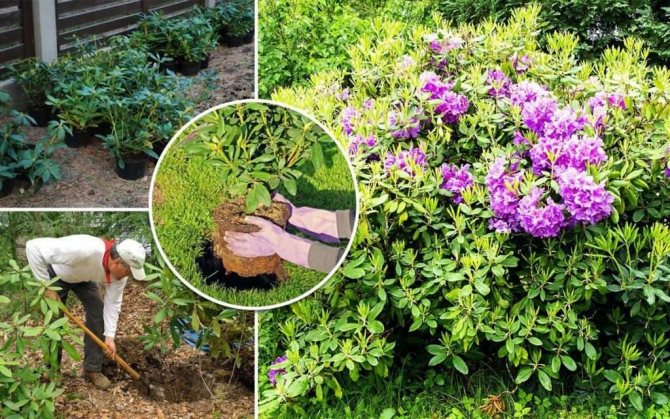

Boarding time
When to plant rhododendron: winter-hardy crops are planted in open ground in spring - in the second half of April to mid-May. Rhododendron planting in the fall can be carried out in September-November. You can plant a tree or bush during the growing season, excluding the flowering time and another 1-2 weeks after it.
Landing place
The place is chosen without the close location of groundwater. If necessary, it is raised, and the pit is well drained to exclude stagnant moisture. Drafts, winds and the burning sun are the enemies of the "rosewood". It is shaded with other tall plants, planted on the north side of buildings or fences, where there is shade. The walls protect the culture from the winds in winter and from the spring sun, which drains it mercilessly. The distance between rhododendrons and walls, fences and other plants should be at least one meter.
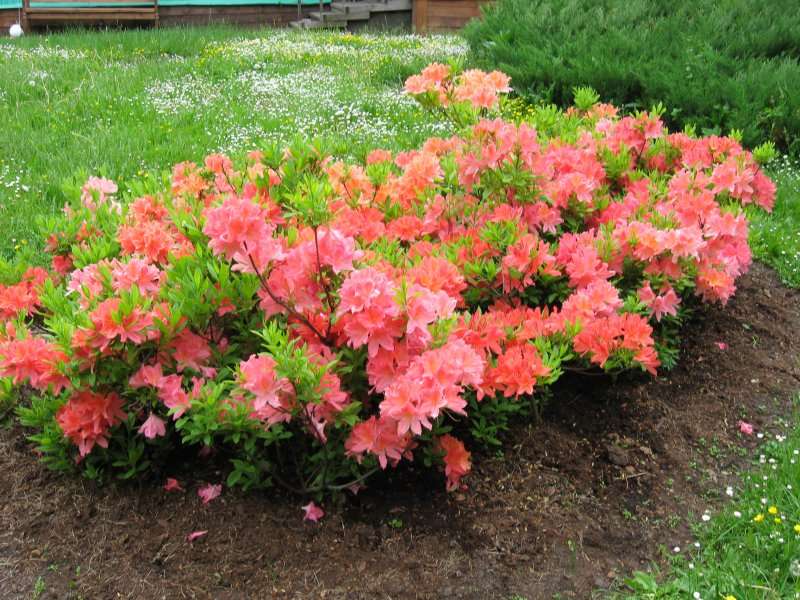

Neighborhood with other cultures
Feel good "trees with roses" next to spruce, pine, thuja or larch with a root system that goes deep into the ground. Discomfort will be noticeable in the vicinity of linden, willow, alder, birch, maple, chestnut, elm, poplar and other plants that have a superficial root system. The roots of these plants will receive food at the same depth as the rhododendrons. The neighborhood with a rose is detrimental to rhododendrons, since they have different soil conditions.


To protect the plant from unnecessary neighborhood, the root system can be protected with slate, roofing material or polyethylene, which is dug into the ground around the pits. From garden plants, pear and apple trees will become good neighbors if the "pink trees" are located at a distance of 1.5-2 m, but not less than 1 m. The distance between rhododendrons during planting must also be maintained. Tall bushes are planted at a distance of up to 2 m, medium-sized - up to 1.5 m, undersized - up to 0.5 - 0.7 m.
The soil
Beginners and experienced gardeners often forget what the soil should be for rhododendron. It should be breathable, humic and acidic, the pH level should be 4.5-5.5 units. There should be no alkalizing substances around the root system, such as ash, dolomite, lime and others. Loosening, digging up the soil in the near-trunk circles is unacceptable, since the root system is located horizontally. Weeds should be pulled out by the roots and the trunks should be mulched to prevent the soil from drying out.
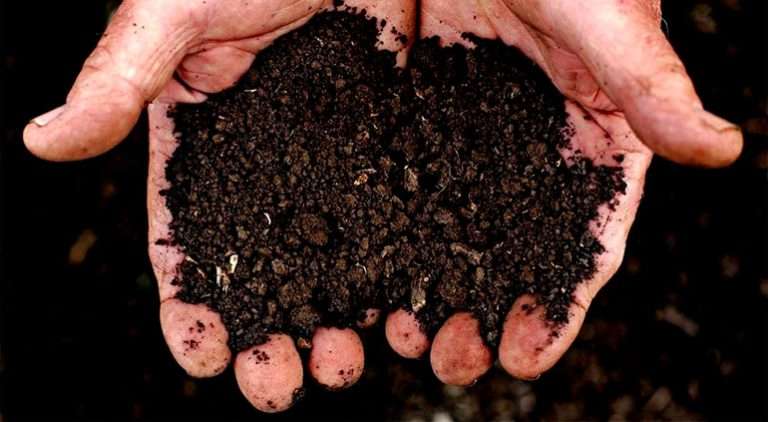

To fill the holes, you should purchase soil for rhododendrons in the store or you can make it yourself by mixing garden soil (black soil), humus, needles (fallen bark and needles, sawdust) and high peat (1: 1: 0.5: 4) or adding complex mineral fertilizer in the ground. Garden centers implement special earthen mixtures for planting crops. If the soil in the garden is clay, then drainage is laid out on the bottom of the holes to a layer thickness of at least 15 cm.Use broken brick or small pebbles for this.
Planting process
The pit should exceed the size of the root system by 2 times, approximately - 80x50 cm.If the seedling is planted in a pot or container, then the roots are kept in water with the anti-stress stimulant Zircon for 30-40 minutes, then they are shaken and straightened. To transplant the plant into open ground, the pot is carefully cut and moved into the hole to the same depth at which it was in the pot, while the root collar is not buried. Do not forget to water the seedling after planting and spread the mulch in the trunk circle.


To propagate a crop, the bushes must be 2-4 years old. Take the most tenacious cuttings branching at the root collar. On the leaves of the seedling there should be no swelling or spots, on the roots - wet blotches and knots.
Rhododendron for the Leningrad region, varieties
The moisture characteristic of the Leningrad Region is perfect for growing rhododendron. But preference should still be given to frost-resistant deciduous and evergreen varieties.
Charming Daurian rhododendron or Ledum
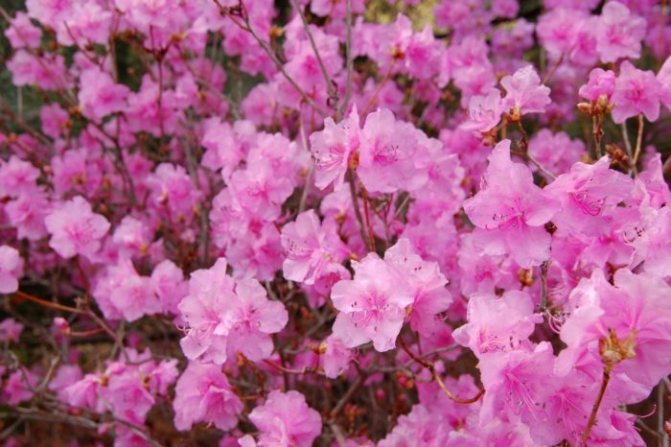

Japanese yellow azalea


Dense rhododendrons such as Azurika or Ramapo


Types of rhododendron: photo
Pest control
The rhododendron shrub can be affected by major garden pests. To combat them, standard methods are used, and infection prevention is carried out twice a season when the plants are sprayed with a Bordeaux mixture.
What pests can appear:
- Slugs and snails can eat leaves and buds. It is more expedient to collect them by hand.
- Bedbugs, scale insects, spider mites, rhododendron mosses and mealy worms can also attack. To destroy such enemies, it is more expedient to use special preparations with an insecticidal effect.
- The most common and effective are "Karbaphos", "Tiram", "Diazin".
- Fungal diseases develop with improper watering, or due to weather troubles. Leaves curl, discoloration and fall off are characteristic features. To combat such a scourge, iron preparations are used, and the problems of moisture and aeration of the soil are also eliminated.
Rhododendron bushes in your garden are sure to attract attention with their abundant flowering and bright color of the petals. Most varieties of this garden plant boast excellent winter hardiness as well as a long flowering period. To do this, it is necessary to ensure optimal conditions, as well as regular care. How rhododendron is planted and further care for this amazing plant is described in our article.
General information
Groups
Flowers are of various shapes, bell-shaped, tubular, funnel-shaped, terry. Large and small inflorescences can be white, purple, pink, yellow in color. Some species have a pleasant aroma.
Divided into groups:
- Deciduous - one of the favorite plants among gardeners, unpretentious to the climate and soil, they calmly endure the winter. It blooms in spring and autumn.
- Semi-deciduous - these shrubs are not tall, calmly endure the winter under a layer of snow. In winter, some of the leaves fall off, a deciduous slingshot remains at the ends of the branches, from which new leaves grow later. The bush produces many flowers.
- Evergreens are tall shrubs, reaching a height of 2-5 m. In winter, dark, dense foliage remains on them. It blooms in large blooms of different colors.Plants grow well in places under tall trees, receiving diffused shade from them, in peat soil.
A detailed description, the rules of planting and care will be considered later in the article.
Appearance description
Inside the flower, seeds ripen in capsules.
Leaves are dense, oval in shape, located on petioles.
The root system is located on the surface and consists of numerous fibrous roots. This feature makes it easy to replant the plant.
The shrub is one of the first spring honey plants.
Top dressing
The flower is fed twice for the whole year:
- Spring - Add nitrogen based fertilizers.
- Summer - Superphosphate is added immediately after flowering.
For convenience, in a gardening store, you can purchase special fertilizers for this plant, which are used strictly according to the instructions. At the end of summer and autumn, the shrub is not fertilized so that it begins to prepare for winter, and does not grow new shoots. Every three years, the top layer of soil is very carefully removed, being careful not to touch the roots. Then a new layer of cow dung mixed with peat is poured on top.
Choosing planting material
Before proceeding to planting a rhododendron, it will not hurt for novice growers to find out what this plant has bred several winter-hardy species... Based on the experience of gardeners, it is best to grow the following varieties on the site:
- deciduous schlippenbach;
- Japanese rhododendron;
- katevbinsky.
Thus, if you want to get high-quality planting material, then you need to be especially careful at the place of purchase. It is best to contact specialized nurseries, where they will not only be able to offer you the desired variety of rhododendron, but also give recommendations on how to care for it.
Don't be tempted by the opportunity to purchase this plant from the spontaneous market. Many of the local sellers often cannot tell exactly what they are selling. And even if the purchased seedling can bloom in summer and decorate your garden, it most likely will not survive the winter and you will have to look for planting material again.
Application in landscape
Rhododendrons are an indispensable attribute of Japanese gardens, alpine slides, park areas. Shrubs are planted in groups or create single plantings. Azaleas go well with roses and conifers.
In Japanese gardens, several species and varieties of rhododendrons are planted with different flowering periods. When one bush fades, another blooms. The effect of continuous flowering is created. Rhododendrons planted next to benches, swings and recreation areas look great.
Group plantings are used to create hedges and curbs. It should be remembered that rhododendron does not lose its decorative properties after flowering.
Through the efforts of breeders, the inhabitants of Siberia can create a Japanese garden in their personal plot. It is important to choose zoned varieties of rhododendrons with good frost resistance. In order to preserve your favorite plants for many years (rhododendrons can live for more than 100 years!), It is recommended to close even the most frost-resistant varieties for the winter.
Landing characteristics
The best time to plant rhododendrons is in the spring, in which case the plant can be well regulated and introduced into a new site.
The root system of the rhododendron is very compact, so even with tall species, it is sufficient to dig a hole about 40 cm deep and 70 cm wide.No unnecessary drainage layer (10-15 cm thick) of broken brick and sand or gravel will stand out at the bottom of the target cave.
The ideal substrate for planting rhododendrons is a mixture of soil, peat and coniferous litter (in a ratio of 3: 2: 1).
It is not superfluous if mineral fertilizers are added up to 70 g at the port. The optimum acidity in the chest is 4.5-5.0 pH. Before planting, the root of a rhododendron removed from the crucible is soaked in water immersed in water and waiting for the release of air bubbles.
The sleeve is planted in a cave filled with substrate, and the root height should be 2-4 cm higher for the soil, taking into account its further shrinkage. Around the bushes close to a hole with enriched edges and abundant water. Rhododendrons have a small, sensitive root system (30-40 cm), which develops mainly in the litter and humus horizon.
That is why mulched material is poured around the planted marshmallows, which retains moisture, prevents overheating of the soil, and protects the roots from mechanical damage. The most suitable are mulch, pine bark or chips, pine needles or peat, the mulching layer should be at least 2-3 cm.
Care and cultivation
Location
For planting plants in open ground, choose a place with diffused light, protected from the wind, which retains moisture for a long time.
Such a place can be found in the shade of taller trees and bushes. Preferably, the neighborhood with those plants whose root system grows deeper, this is an oak, pine, apple, pear.
Important!
Loosening the soil is not included in the care of rhododendrons. Since his root system consists of tangled, fine hairs that grow superficially.
Better to mulch the soil! And remove the weeds manually.
The soil
The soil should be loose, well fertilized with organic matter, with a well acidic pH.
To acidify the soil, you can use a ready-made heather mixture. Can be acidified with peat.
Using "Mycorrhiza" for heather plants, the root system will be nourished by the symbiotic fungi that are part of it.
Then the plant will always have favorable growth, no matter what the pH of the soil.
Fertilizers
For active growth, the shrub requires additional nutrition. Top dressing begins to be applied from April to August. Introduce in dosed portions, evenly.
The lack of minerals in a plant can be determined by some signs:
- The appearance of dark red spots on the edges of the leaf blades is a lack of boron.
- The leaf tissue between the veins turns yellow - a lack of potassium.
- The leaf remains green, and the places near the veins turn yellow - a lack of iron.
With weak flowering and pallor of the leaves, ammonium sulfate is used. It is used in the spring and summer.
In autumn, the soil is acidified with potassium sulfate, which will help the plants prepare for wintering.
For active growth of flower buds and longer flowering periods, granular superphosphate is poured onto the moistened soil.
In specialized stores, you can buy ready-made mineral complexes for rhododendrons. They contain macro and microelements.
Watering
Rhododendron is a moisture-loving plant, but everything should be in moderation.
In order to prevent root decay, the watering time is determined by the withering leaves.
Also, the shrub loves surface spraying of foliage.
Pruning
In the spring, cut off dry, frozen branches.
Pruning will give the appearance of new shoots, the removal of diseased branches, and will form the decorative effect of the bush.
After flowering, the faded inflorescences are removed. They are carefully broken off by hand, imitating natural subsidence.
Artificially removing the inflorescence will help the shrub gain strength and next year it will give more abundant flowering.
Preparing for winter
Rhododendron is a frost-resistant plant. But if the winter is snowless and frosty, it is better to cover the soil with dry foliage, peat, and needles.
Deciduous species, azaleas and Finnish varieties, Haaga and Helsinki are the easiest to tolerate in winter.
Japanese rhododendrons need to be covered for the winter.
The whole bush is wrapped in a piece of film, well covered at the base of the bush in order to preserve the root collar.
Also for wrapping material is used - agrotextile. They wrap the bush 2-3 times and fix it tightly.
You can insulate the bushes with spruce branches, covering the bush at the base, this will create a natural protection, and the snow that has fallen will serve as a warm fur coat.
Autumn care, shelter
Most rhododendrons do not tolerate severe winter frosts. Therefore, from the fall, they need to provide shelter. Do this after the first frost. Sprinkle the horse neck with dry leaves, preferably oak leaves. It is recommended to cover undersized varieties completely. Make a frame around the bush, cover it with lutrasil. The branches of higher rhododendrons are bent to the ground and pinned with hooks. Cover with spruce branches from above. Evergreen varieties that overwinter with leaves must be protected from direct sun. For them, frames are made of roofing material or plywood. They protect the bush not only from the sun, but also from strong winds.
With the onset of spring, when the snow melts, the frame can be removed. It is better to choose a cloudy day for this. In regions with a warm climate, many species of rhododendron do not need shelter, since they are considered quite frost-resistant.
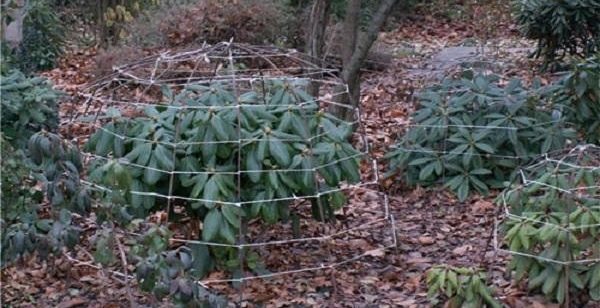

Growth features
Rhododendrons can grow in any locality and climate - you just need to choose the right variety. This is not a problem, since there are about 3 thousand species. This is a rather unpretentious plant that tolerates transplantation well, since it has a superficial root system, which can be dug out with a shovel.
Seat selection
If there is any structure on the site, then the rhododendron bush must be planted from the north side. The place will be located in the shade, which is suitable for everyone, since most garden ornamental crops prefer a southern well-lit garden bed.
It is not recommended to plant rhododendrons with those plants, the root system of which is located on the same level with the bush. In this case, they will compete for nutrients:
- Linden;
- alder;
- chestnut;
- willow;
- poplar.
It can be planted next to a pear and an apple tree - these are the favorite neighbors of the shrub, as well as oak, pine and larch. This will be of mutual benefit as the rhododendron needs acidic soil and the needles can provide the desired pH level.
If, nevertheless, there are no options, then the rhododendron root is fenced off with an underground structure - slate or other solid material is dug in so that the plants could be watered and fed separately.
Since the rhododendron bush does not like stagnation of moisture in the soil, it is necessary to check at what depth of the site the groundwater lies. If the distance is less than a meter, create an artificially raised bed for the rhododendron. Its height must be at least 50 cm.
If the plant has not taken the place to which it was determined, it is advisable to transplant, otherwise problems with decorativeness will be permanent.
Temperature in summer and winter
If you choose the right variety for the climatic region, there will be no problems with growing in summer and winter. It is not advisable to violate the rules for choosing a place, since the bright rays of the sun have a bad effect on flower stalks - they fade faster. This is especially true of late flowering rhododendrons.
Rhododendron needs temperature in winter from 5 to 8 degrees maximum, as the growth of flower buds occurs.
In room conditions, compliance with the temperature regime is much more important. The indoor rhododendron is called Azalea. Many people buy beautiful flowering plants in the store, but after a week they begin to wither.
The thing is that even in the summer, the azalea should be at a temperature of 10 to 15 degrees, and in winter at 6 - 8. It is almost impossible to achieve such a low temperature in an apartment, so the culture will not last long.
The best option is a winter garden, which is not heated, but then only plants of this type should be in it, since low temperatures are contraindicated for the rest.
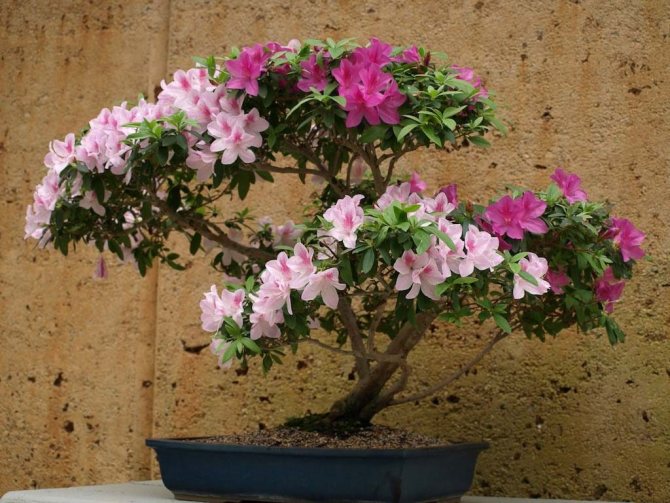

Important! Before you buy your favorite expensive plant (azaleas-rhododendrons are far from cheap), you need to read about the conditions of their growth in the apartment
At high temperatures, indoor rhododendrons begin to hurt and are affected by pests - primarily spider mites. It is very difficult to cure a plant without changing temperature conditions.The second disadvantage is poor rooting of cuttings for propagation.
Watering
Most rhododendron flowering trees love moist soil and do not tolerate drought. Rhododendron is often watered, since its superficial root system is not able to get water deeper than 1 m, therefore it dries up quickly. With each watering, there should be enough liquid to moisten the soil layer to a depth of 35 cm.
The water must be soft, as the plant does not tolerate lime salts. To do this, it is advisable to keep a barrel of rainwater in the yard. Mulching with coniferous needles will help to preserve moisture, since they decompose and maintain an acidic environment.
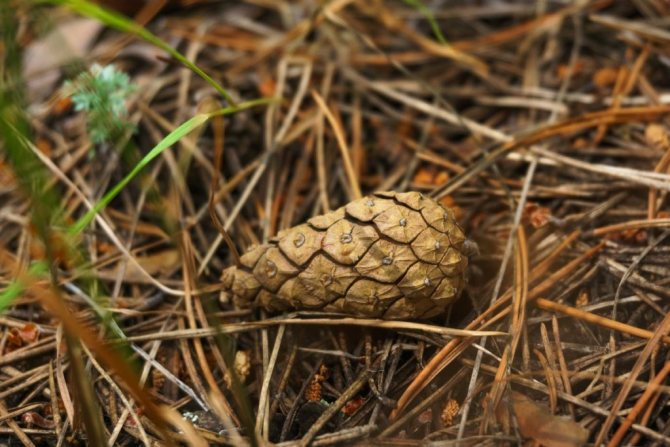

In the hot season, it is useful to carry out sprinkling, but this should be done in the evening, so that during the night the leaves also have time to be saturated with moisture. The plant needs most of the water during the flowering period so that the inflorescences do not crumble ahead of time. When rhododendron blooms, you can put a hose under the bush and turn on a small pressure. So that the water does not spread, they equip an earthen rampart around the bush.
Young bushes require more frequent watering - 4 - 5 times a week in summer. Mature plants - three times per week. To maintain the desired level of acidity, citric acid is added to the liquid - 4 g per bucket of water. Oxalic, wine, and vinegar are also suitable.
After watering, the soil must be loosened, but do this carefully so as not to damage the roots.
Soil and acidity requirements
The soil for rhododendrons is prepared at the planting stage. For this, sour high-moor peat is mixed with sand and garden soil. You can add sawdust from conifers - they have a high acidity, so they are not used for other plants.
The roots must receive enough air so that they do not rot in an acidic environment. If the site consists of loam or even heavier clay, the soil for the rhododendron is made up of several components, most of which will be loose. In equal parts take:
- humus;
- horse peat;
- sand.
A high humus content is another prerequisite for growth and flowering. Humic acids have a positive effect on the immunity of all ornamental crops. They contain vitamins and chemical compounds that are responsible for the metabolism. Humus is introduced into the soil to attract soil microorganisms and earthworms for processing it into humus.
Before planting rhododendron, it is recommended to check the soil for acidity. You can use a pH meter that is pre-calibrated in distilled water. There are also folk methods. One of them is based on the use of black currant or cherry leaves.
How to check:
- Pour boiling water over a handful of leaves, wait until they are brewed.
- Take land from the garden where you plan to plant the rhododendron.
- Throw it in a glass of tea leaves.
If the liquid changed color and became green, then the soil in the area is neutral - acidic components must be added. Red indicates a normal acid level - in this case, nothing needs to be done. The blue color of the tea leaves indicates that the soil is slightly acidic; a little sawdust or needles need to be added. The overall pH should be between 4.5 and 5.5 units.
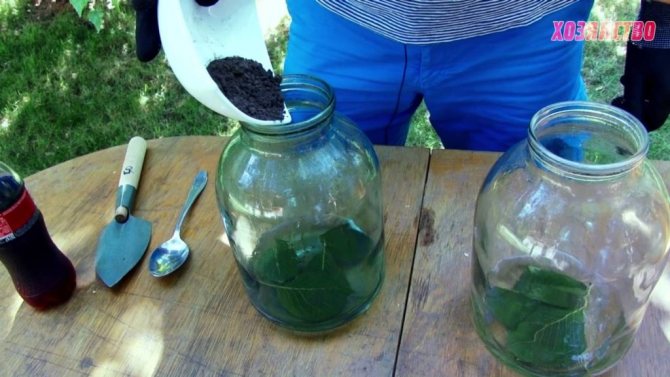

Usually, experienced gardeners recommend preparing a bed for rhododendrons in the fall, digging up the soil with coniferous sawdust or needles. During the winter, they will have time to rot and create suitable conditions for planting rhododendrons. Layer height should be about 35 cm.
Top dressing
"Feeding" such large inflorescences is possible only with the regular introduction of nutrients for the plant. Caring for rhododendron during and after flowering includes the use of organic and mineral fertilizers. On sale you can find special complex mixtures of acidic substances, so as not to compose them yourself.
Of acidic fertilizers, the following are recommended:
- Potassium sulfate is added to stimulate and maintain flowering.
- Superphosphate.
- Ammonium sulfate, magnesium.
The secret why rhododendron blooms so magnificently lies in the peculiarities of its metabolism. For flowering, you need a lot of phosphorus and potassium, but potassium is absorbed as much as phosphates are processed. To dissolve phosphorus in the soil, an acidic environment is needed - in the case of rhododendron and its large inflorescences, which consume a lot of nutrients, it is very acidic.
You need to fertilize the plants in early May (no later than the middle). If there are not enough iron ions in the soil, the leaves will begin to turn yellow. The same is true if the soil has lost its acidity. Beginners sometimes spoil the bush themselves by introducing wood ash as an organic fertilizer. The fact is that it contains a large amount of carbonates that alkalize the soil, which is fatal for rhododendron.
If the conditions for acidic fertilizing and watering are not met, the plant begins to suffer from chlorosis, sets few flowers, as it saves energy. Weakened bushes are prone to pest infestation, tissue cancer.
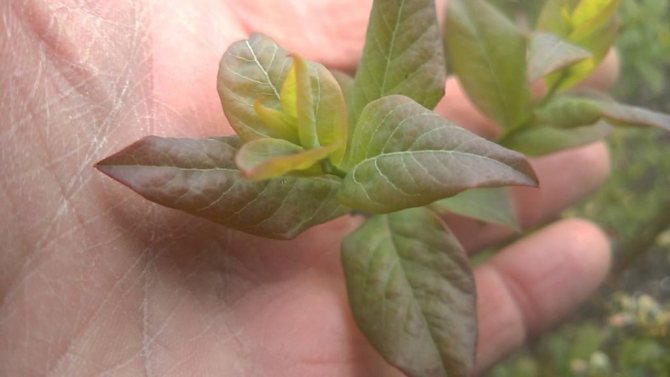

Rhododendrons: growth and care
But plant species can also be found in sales.
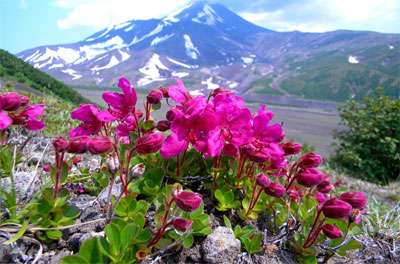

One of the smallest species -
Rhododendron Kamchatka
(Rhododendron camchaticum). The pike bucket does not exceed 20 cm in height with a diameter of up to 40 cm.The famous shape with growing shoots reaches a height of 40 cm.
Flowers from the first decade of June are excellent for such miniature plants with dense black flowers in small (1-3 flower) inflorescences.
It is not strange, completely winter-dependent, it has a moderate growth rate. Well on the terraces of stone gardens, in the foreground compositions with dwarf conifers.
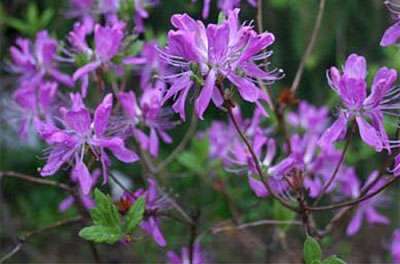

Rhododendron canadian
(Rh.
Canadense) refers to early flowering.
Densely branching bushes reach a height and diameter of 1 m with age. Light purple, softly carved flowers bloom profusely from early May until the leaves open. If the spring is cool, then flowering takes up to 3 weeks. A nice white flower shape is also good. The species is quite wintry, persistent in color, but grows faster on dry sandy soil and needs to be replaced.
The longer it is decorative for moisture-intensive soils, while maintaining high humidity.
It looks good in one planting, in perennial complexes, including early spring ephemeroids (Scilla Difolia, hionodoksy, windsurfing) in a group planting nearby ponds and streams.
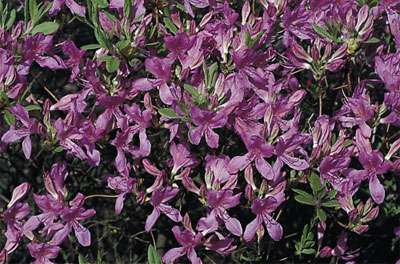

More plastic in culture Rhododendron Fraser
(Rh.
x fraseri). It is a hybrid of soft rhododendron, accumulated about 100 years ago, but it has only recently appeared on our market.
The elegant flower shape and densely branched shoots from the soft rhododendron flower and good adaptation to different garden conditions are inherited from the Canadian rhododendron. Flowers later Canadian, from the second half of May.
It is good on both single and group plantations, especially in yellowish and yellowish varieties of rhododendron.


Rumodendron yellow
(Rh.
luteum), the so-called Pontic azaleas, is an undemanding species that is often recommended for beginners. Indeed, fast growing, in a state of hibernation, very fragrant golden flowers bloom effectively in large inflorescences from mid-May 3 weeks. It develops thick shrubs about 150 cm high and equal in diameter.
Stunning light color. Full bloom and moderate shading, but a harmonious shrub only forms in bright spots. At the same time, it suffers from overheating and dry air in a fully illuminated outdoor area. The hardest part about growing this type is choosing the optimal lighting.
In large gardens, rhododendron is planted in yellow at the edge. In small gardens, groups of evergreen and deciduous rhododendrons are found in the middle or back, between conifers (western varieties, cypresses).


Japanese rhododendron (R h.
japonicum) is a widespread winter-hard species that constantly blooms from the second half of May for 2-3 weeks.
The flowers are large, salmon pink, and it is also a very showy golden-floral form.The average height of a blackberry is about 100 cm, but there are larger specimens.
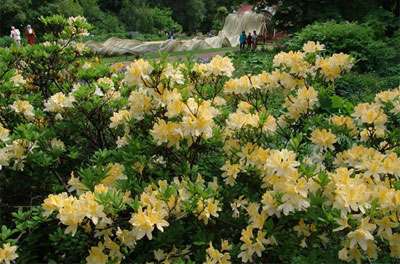

Close to this point of view Rhododendron soft
(Rh. Molle) bloom at the same time, but the bush itself is slightly smaller, the flowers are creamy yellowish, delicate shadows.
Both species are not difficult to culture, they work well in bright, free areas of the wind. When shading suffers, the shape of the bush suffers, flowering is weakened. These plants appear as medium-sized conifers (varieties of western arborvite, mountain pine), large terraces of mountain gardens, on group plantations with deciduous or evergreen species and varieties.


Rhododendroni, Atlantic
(Rh. Atlanticum),
pink
(Rh.
prinophylum) and sticky
(Rh. Viscosum) belong to the North American species. Species reach a height of 100-120 cm, pink rhododendron -. 140 cm. Small fragrant flowers in white and pink palettes, decorated with many projections, buds are more intensely colored than flowers.
Flowers later - from the beginning of June and from rhododendron sticky - from the second half to the end of June. Plants are undemanding, winter-hardy, moon bloom. They are well suited for planting and planting in a group, among perennial plants from the natural flora, with the formation of an “undergrowth” bloom at the edge.
It is impossible, at least briefly, to mention such rare sales, but extremely beautiful and persistent types, such as:
|
| |
| Rhododendron Albrecht (Rh. albrechtii) (dense, up to 170 cm high bushes with large leaves, yellow flowers appear in mid-May) | Rhizodendron Vaseya (Rh. Vaseyi) (exquisite shrubs up to a height of 150 cm with thin branches, white-pink flowers from the end of May). We are not capricious for both species, they persistently bloom. |
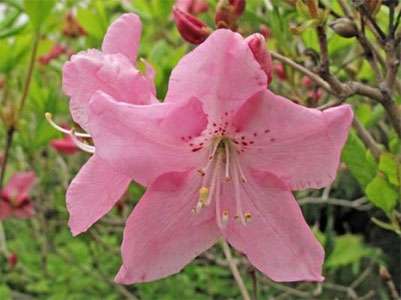

Rhododendron from Schlippenbach
(Rh. Schlippenbachii) is one of the most diverse species. The delicate pink flowers bloom early, from late April to early May.
Mature shrubs reach a height of 150 cm and are equal in diameter.
A plant with a very beautiful autumn leaf flower. In culture, this rhododendron is complex - flowers ready to bloom, often blinking with repeated frost, is also difficult to satisfy the planting. Saplings develop rather slowly.
Of the varieties of deciduous rhododendrons, they are the most represented in our market. Knapp-Hill-Exbury hybrids
.
|
As a rule, winter is solid, but not all of us thrive abundantly every year.
This means that flowering stability varies greatly from variety to variety. Between the flower of the white flower, the giant flower is different Schnegold (Schneegold). The bush has a good growth rate. Among the orange varieties, attention should be paid Gibraltar (Gibraltar). It also has large orange-orange flowers, dense inflorescences, rather thick bushes.
Classes in red, they usually form an upright, low stem of shrubs, and it is very difficult to achieve flowering over the entire surface of the crown.
Nice colors Fireworks (Feuerwerk), very beautiful, dark red from Nabucco flowers (Nabucco). The ideal shrub shape is Il Tasso.
The flowers are berry red, fragrant, with a double carriage. A beautiful, dense, rich flower bush also forms a silver boot. Flowers are soft cream, leaves with anthocyanin shade. In autumn, unusual violet-violet colors.
| |
| I will quote from the varieties of pink flowers Homebush (Homebush) - the inflorescence is very dense, rounded, reminiscent of the flowering of the larynx, low bushes, | Sylphs (Sulfides) - tall, with a dense twig, large pink flowers with orange pelia. |
Of course, this is not a complete list of Nap-Hill-Exbyury varieties that have been tested in our conditions, only a few of them are given, for example.
The height of the ten year old scrub of this group ranges from 80 cm (in small classes) to 140 cm (above).
The beginning of flowering is from the end of May at the beginning, to the middle of June - late. The indisputable advantages of these plants are different colors and shapes of flowers, inflorescence values, texture density of petals, flowering time (up to 4 weeks).
With the same inflorescence, they practically do not suffer from rain and dew. If you want to fully develop the varieties of this group, you need a fully illuminated area without wind.
Another very promising group of species is gentleman
(Ghent) -
hybrids
.
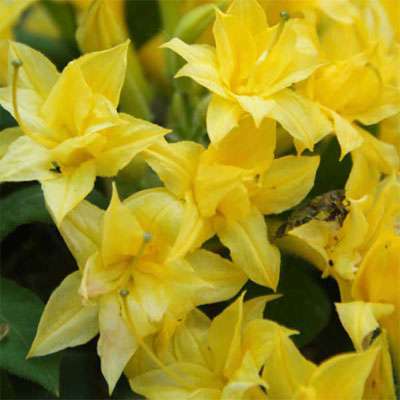

Among them there are varieties of a century and a half ago - Nartsissiflora (Narcissiflora) (pale yellow flowers with a double corolla) Daviezi (Daviesii), and recently appear in Finland - white Illyuzhn (Illusion), and glowing red of various shades Adalminta (Adalminta) Aamursko.
They are all winter-hardy, suffer from genten hybrid narcispheric penumbra, they grow quite quickly. The average rating of this group is higher than the Knapp-Hill-Exbury hybrids.
So-called motis
(Mollis) - Azalea -
hybrids
Japanese and soft rhododendrons.
Fully stable and stable flowering rhododendron with flowers in different shades of yellow and red.
Required lighting. They are comparable in size to the original type.
The most stubborn and stable bloom varieties are the Northern Lights series. They have been accepted for the past thirty years in the state of Minnesota, USA.
The hybridization program included North American winter hard species and Knapp-Hill-Ekbury hybrids.
| Pink lights form the height of the bushes 160 cm, the flowers are bright pink, fragrant. It begins to flourish from the end of May. White lights - 150 cm tall, buds are soft pink, white flowers, fragrant. It blooms in early June. | Nosern Hi Lites (Northern Hi Lights) - bushes up to a height of 140 cm, very thick, creamy flowers with yellow spots, flowers closer to mid-June. | Mandarin lights (tangerine lights) - a bright orange flower, a bush 150 cm high, blooms in the first half of June. |
All varieties of this series grow rapidly, bloom profusely and develop well-shaped shrubs in full sun and partial shade.
The flowers are smaller than the Knapp-Hill-Ekbury group, but the number of infections is higher.
The use of deciduous rhododendrons in the garden varies. They decorate a mixture of woody shrubs, any composition with acicular species, with perennials. Suitable for large stone gardens, in compositions stylized in Japanese and Chinese motives.
Fertilizing and feeding rhododendron
In the first year, the transplanted plants already require careful fertilization, which is applied in a highly diluted form, in small portions. The plant itself will signal the need for fertilization: it will stop growing, discard the foliage or the leaves change color, the formation of flower buds will stop.
Organic fertilizer for feeding rhododendron bushes - semi-decomposed manure, which must be infused in water. Top dressing is carried out with an aqueous solution of manure. To increase the formation of flower buds, as well as to extend the flowering period, granular superphosphate, or double superphosphate, is used, which is scattered over the moist soil under the plants. The plant is also useful for fertilizing with microelements - fertilizers are applied in the form of watering or spraying the green mass of the bush. Intensive fertilization of the bushes is required until the end of August.
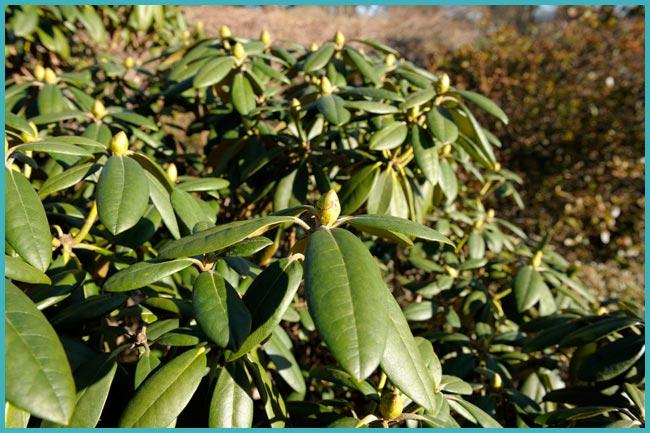

Rhododendron before flowering
Rhododendron after flowering
Rhododendron in autumn
If the autumn turns out to be dry, the rhododendron must be watered abundantly - 10-12 liters for each bush. If it's autumn, as usual, with rains, then you won't have to water the rhododendrons. By November, each bush is insulated in the root zone, laying a layer of peat along the near-trunk circle.
- Planting hyacinths in the garden
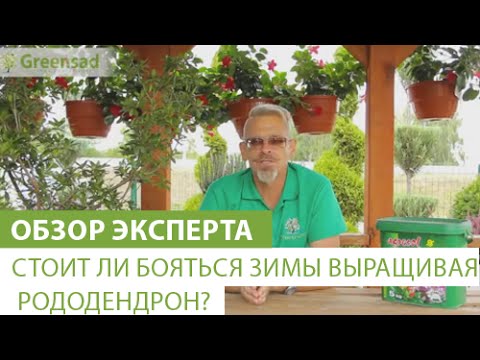

Rhododendron in winter
If you live in the middle lane, with the first frosts, the rhododendron bushes need to be covered with burlap, after having put spruce and pine branches between the branches and slightly pulling the bush with twine. The bags are removed on a cloudy day in early spring, as soon as the snow melts. In warmer regions, rhododendrons hibernate without shelter.
Description and general information
In Siberia
In nature
Azalea can be both an evergreen semi-deciduous or deciduous tree, and a shrub belonging to the Heather family. There are about 1300 species of rhododendrons in the world.This also includes the demanded indoor azaleas, or as it is also called the "Rosewood", because the inflorescences can really be compared with some rosaceous, for example, floribunda roses.
You can meet the plant not only in the garden, but also in the wild. So where does the rhododendron grow? The shrub grows freely in southern China, Japan, North America, the Himalayas, as well as Southeast Asia. The most common environment where unusual flowers can be found is near rivers, seas and oceans. You can see a miniature bush, whose height will be no more than 30 cm, in addition, you can enjoy the flowering shrubs covering the ground. Each species has original inflorescences, which can have a variety of shapes, colors and sizes. The largest flowers have a circumference of 20 cm.
Rhododendron: combination with other plants
Planting plants in combination with conifers and a group of heathers has a positive effect on the development of rhododendrons. It should be remembered about the height of the rhododendron bush. Low cultivars should be located away from the dense shade of mature trees, but avoiding direct sunlight.
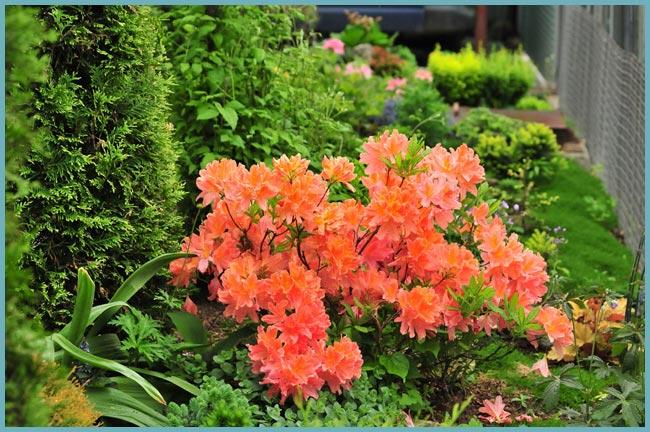

Blooming rhododendron perfectly sets off conifers
An excellent combination is observed when located next to the rhododendrons of shade-loving ferns and host.
Transplanting bushes in the garden
A rhododendron transplant in summer or spring is carried out taking into account one important nuance - you cannot disturb a flowering plant. The rest of the bush will survive. Experienced flower growers are engaged in transplanting in any growing season - in spring, autumn, summer.
How to properly transfer the bush to another place:
- If the soil is at the correct pH level, you can immediately dig a hole. Its dimensions are 50 cm deep, 60 cm wide. This applies to a small bush, the root system of which is placed in a hole with a margin.
- While the pit is being created, the rhododendron can be placed in acidified rainwater to prepare the roots for planting.
- Drainage is laid at the bottom - you can fill in red brick or pour in purchased expanded clay - it accumulates moisture and is able to gradually give it to the roots.
- On top of the drainage, a layer of soil with coniferous sawdust, rotted needles, peat and sand is poured.
- The plant is installed in a hole so that the root collar does not go deeper than it was in the previous place.
- Gradually, soil is poured and compacted so that large air pockets do not appear. It is important to compress the soil near the roots so that they immediately begin to receive nutrients.
- After planting, the plant is watered with warm acidic water. You can soften the water by adding high peat to it a day or two before watering.
After planting, the bushes are strengthened with a support, driving in 3 - 4 pegs and entangling them with wire or rope. While the plant is rooting, but this happens depending on the variety from 1.5 to 5 months, the support will protect it from the wind. After rooting, it can be removed.
Video: Flower care
How to feed rhododendrons
For feeding, special fertilizers for rhododendrons are suitable. They have a sour reaction. If you don't sell them, you can get by with the Kemira-wagon. Take the recommended dose, mix with mulch and pour over. That's all.
Rhododendrons should be fed 2 times a year: in June-July, when they bloom, and in early spring.
Be sure to follow the dosage, otherwise you can burn the roots!
Ash for feeding rhododendrons is not suitable! She's got an alkaline reaction.
In most areas, the soil is too alkaline for rhododendrons. That is why special soil needs to be prepared. Tips to water the bushes with acidified water are more suitable if the plants already require resuscitation. Therefore, it is better to plant them right away right away. It is much easier to lightly powder the soil with colloidal sulfur if there is not enough acidity.
Pests
During the growing season, pests attack the shrub, causing numerous damage - spots, holes in the leaves, discoloration, distortion of shoots and leaves. We will tell you how to deal with pests of rhododendrons, how to prevent their appearance.
Pests that make holes in the leaves
Single skosar
Holes at the edges of the leaves, yellowing, drying out of the bushes are signs of the appearance of Solitary Skosar. Black adults, 8-11 mm long, damage rhododendron leaves in May-June. Beetles feed at night, hiding in the ground during the day. Females lay eggs in the ground, from which larvae hatch, damaging the roots. Skosar attacks other garden plants with fleshy leaves, like rhododendron.
Control measures: after removing damaged leaves, late in the evening the plants are sprayed with Fastac 100 EC insecticide (at a concentration of 0.02%). It is important to control the beetles before they lay their eggs, the control of the larvae is difficult, often ineffective.


Pear bug
Signs of a pear bug (Stephanitis oberti) attack:
- yellow, mosaic spots on the upper side of the leaves;
- dark waste resembling resin appears under the leaves;
- the eggs of the pest hibernate on the underside of the leaves; at the end, wingless larvae appear in yellowish-brown color.
Adults appear in July.
Bedbug-infected rhododendrons are sprayed with drugs of your choice:
- Decis 2.5 EC (concentration 0.05%);
- Sumi-alpha 050 EC (concentration 0.04%).
The treatment of the plant from the bug must be repeated.


Pests causing yellowing of leaves
Some pests cause yellowing of the leaves, which can easily be mistaken for disease symptoms.
Whitefly
The sticky, yellowed leaves of rhododendrons may indicate that the plant has been attacked by a whitefly. Around the bushes in May-June, small white butterflies are visible - insects 1.2 mm long, bright yellow, with white wings. The females lay eggs on the underside of the leaves, then the greenish-yellow larvae hatch, releasing large amounts of nectar on which the fungi grow, forming a black coating on the leaves.
Control measures. After the whitefly is found between June and July (adults feed the larvae), the infected plants are treated 2 times with an interval of 14 days with Provado Plus AE insecticide.


Aphid
In spring, aphids form large colonies on the youngest, growing leaves. The insect sucks out plant juices, strongly inhibiting the growth of young shoots, distorting the leaves, polluting them with honeydew and numerous white cuts.
The fight against aphids begins immediately after detection. The bushes should be sprayed with:
- an antiparasitic drug, for example, Karate Zeon 050 CS (at a concentration of 0.02%);
- if you do not want to use "chemistry" in the garden, you should use the natural preparation Agricolle.
Preventive measures: preventively, you can treat the plant with a solution of potassium soap with the aroma of garlic.


Rhododendron for the Moscow region, varieties, names
The climate in the Moscow region cannot be called harsh, but it is changeable, and therefore the choice of a variety must be approached responsibly. In this part of Russia, cold winters alternate with mild ones, and summers can be dry or damp. For these reasons, it is better to choose winter-hardy varieties, but the species can be either deciduous or evergreen. The varieties bred in the USA and European countries are best suited.
Deciduous variety Mandarin Lights


Semi-evergreen dwarf Purpurkissen
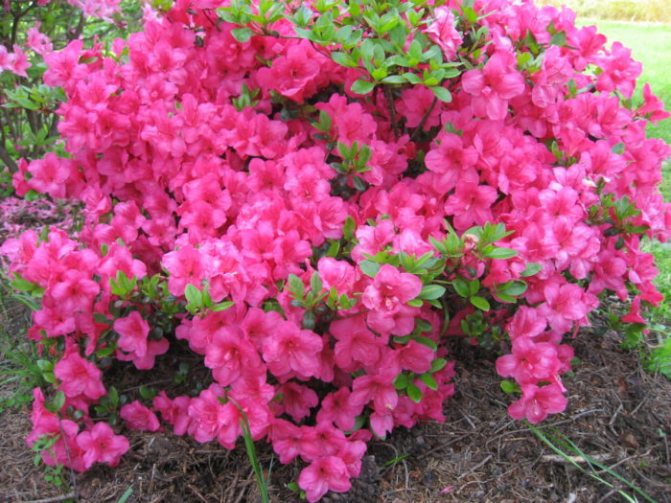

Deciduous azalea Golden sunset
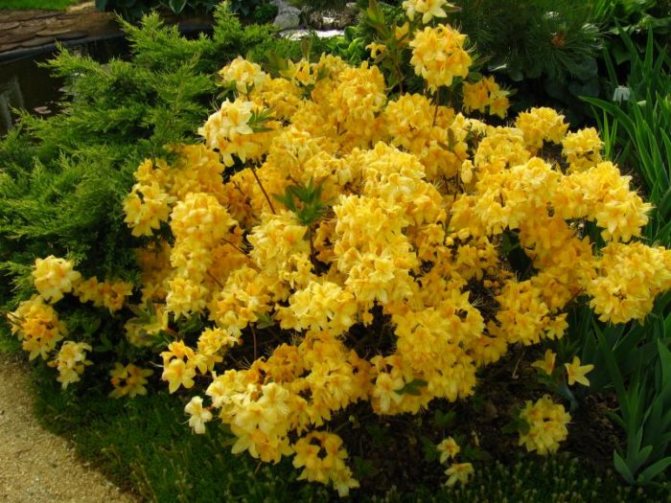

Evergreen rhododendron Katevbinsky
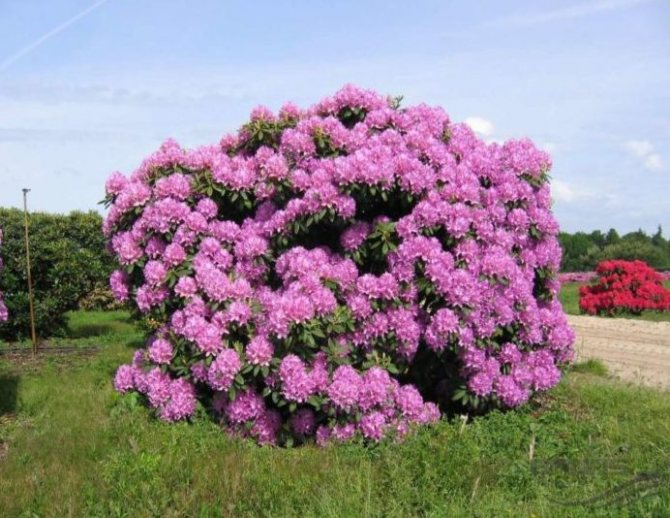

Shelter for the winter
Since the winter in the northern region is very harsh, even frost-resistant varieties of flowering shrubs may not survive it. Therefore, every autumn they must be covered for the winter. This should be done as soon as the temperature has dropped to zero.
First, the root system around the trunk is mulched with peat or covering material. Then the entire crown is collected and carefully bent to the ground.Wrapped in burlap or covering material. It is recommended to remove the shelter in the Urals not earlier than in mid-April, when the weather is already warm.
Features of rhododendron
The garden rhododendron is a shrub. Different species can differ from each other in the size and shape of the leaf plates, which are biennial, annual and perennial, petiolate or sessile, alternate, serrate or entire, obovate or ovate. This plant is relatively popular in all countries of the world due to its decorative foliage, as well as beautiful flowers that are part of racemose or corymbose inflorescences that look like bouquets of amazing beauty. Flowers can be pink, purple, white, red or purple. The shape of the flowers directly depends on the type and variety of the plant and can be funnel-shaped, tubular, bell-shaped or wheel-shaped. In some species, flowers have a pleasant smell. The fruit is a five-leafed polyspermous capsule with two-millimeter seeds inside. The superficial compact root system of this culture consists of a large number of fibrous roots. Due to the fact that the root system is shallow, transplanting rhododendron is quite easy and the plant tolerates it well. This shrub is considered an excellent early spring honey plant.
Rhododendron. Useful properties of the plant
Few people know, but rhododendron has excellent medicinal properties. In parts of this plant, vitamin C is found in high concentration, arbutin, ericolin, rhododendrin, andromedotoxin. The plant is widely used in folk medicine for the following purposes:
- the plant can have a beneficial effect on the work of the cardiovascular system;
- folk remedies based on rhododendron can lower blood pressure;
- the plant can have an antipyretic effect in viral diseases;
- in folk medicine, the analgesic effect of rhododendron on the human body is also noted;
- the use of traditional medicine based on rhododendron is useful for people suffering from disorders of the nervous system. The plant has a calming and relaxing effect.
Of course, before using any medicinal plant, including rhododendron, you should consult your doctor. It is especially worth avoiding such methods of treatment for pregnant women, women who are breastfeeding, children, people with diseases in the acute phase. Any plant can cause an unexpected allergic reaction in the body. Be careful!
Rhododendrons in Siberia, according to summer residents, have shown themselves to be excellent plants for growing in this climatic zone. Do not believe in the myths about the excessive capriciousness of this shrub and the incredible difficulties of leaving. As you have seen from the article, rhododendrons are quite easy to grow. The main thing that is required of you is to thoroughly approach the choice of a winter-hardy variety.

